`shapr`: Explaining individual machine learning predictions with Shapley values
Martin Jullum, Camilla Lingjærde, Lars Henry Berge Olsen & Nikolai Sellereite
Source:vignettes/general_usage.Rmd
general_usage.RmdIntroduction
The shapr package implements an extended version of the
Kernel SHAP method for approximating Shapley values (Lundberg and Lee (2017)), in which dependence
between the features is taken into account (Aas,
Jullum, and Løland (2021)).
Estimation of Shapley values is of interest when attempting to explain complex machine learning models. Of existing work on interpreting individual predictions, Shapley values is regarded to be the only model-agnostic explanation method with a solid theoretical foundation (Lundberg and Lee (2017)). Kernel SHAP is a computationally efficient approximation to Shapley values in higher dimensions, but it assumes independent features. Aas, Jullum, and Løland (2021) extends the Kernel SHAP method to handle dependent features, resulting in more accurate approximations to the true Shapley values. See the paper (Aas, Jullum, and Løland (2021)) for further details.
Overview of Package
Functionality
Here is an overview of the main functions. You can read their
documentation and see examples with ?function_name.
| Function Name | Description |
|---|---|
explain |
Computes Shapley values for a model and a set of observations to explain. |
explain_forecast |
Analogous to explain, but for explaining
forecasts from time series models. |
plot.shapr |
Plots the individual prediction explanations. Uses the
ggplot and ggbeeswarm package. |
plot_SV_several_approaches |
Compare the individual prediction explanations obtained from different approaches. |
plot_MSEv_eval_crit |
Plots the criterion to evaluate the performance of the approach. |
print.shapr |
Prints the Shapley values (default), their standard deviation or estimates of the MSE. |
get_results |
Extracts and returns a summary of the Shapley value computation. |
summary.shapr |
Returns a summary.shapr object, and prints
a formatted summary when called interactively. |
The shapr package implements Kernel SHAP estimation of
dependence-aware Shapley values with eight different Monte Carlo-based
approaches for estimating the conditional distributions of the data,
namely "empirical", "gaussian",
"copula", "ctree", "vaeac",
"categorical", "timeseries", and
"independence". shapr has also implemented two
regression-based approaches "regression_separate" and
"regression_surrogate". See Estimation
approaches and plotting functionality below for examples. It is also
possible to combine the different approaches, see the combined approach.
The package allows for parallelized computation through the
future package, see Parallelization for
details.
The level of detail in the output can be controlled through the
verbose argument. In addition, progress updates on the
process of estimating the v(S)’s (and training the
"vaeac" model) is available through the
progressr package, supporting progress updates also for
parallelized computation. See Verbosity and progress
updates for details.
Moreover, the default behavior is to estimate the Shapley values
iteratively, with an increasing number of feature coalitions being
added, and to stop estimation as the estimated Shapley values have
achieved a certain level of stability. More information about this is
provided in Iterative estimation The above,
combined with batch computation of the v(S) values, enables
fast and accurate estimation of the Shapley values in a memory-friendly
manner.
The package provides functionality for printing and summarizing the Shapley value computation, as well as extracting objects created during computation, see Summary, Printing, and Result Extraction.
The package also provides functionality for computing Shapley values for groups of features, and custom function explanation, see Advanced usage. Finally, explanation of multiple output time series forecasting models are discussed in Explaining forecasting models.
Default behavior of explain
Below we provide brief descriptions of the most important parts of
the default behavior of the explain function.
By default explain always computes feature-wise Shapley
values. Groups of features can be explained by providing the feature
groups through the group argument.
When there are five or fewer features (or feature groups), iterative
estimation is by default disabled. The reason for this is that it is
usually faster to estimate the Shapley values for all possible
coalitions (v(S)), than to estimate the uncertainty of the
Shapley values, and potentially stop estimation earlier. While iterative
estimation is the default starting from six features, it is mainly when
there are more than ten features, that it is most beneficial, and can
save a lot of computation time. The reason for this is that the number
of possible coalitions grows exponentially. These defaults can be
overridden by setting the iterative argument to
TRUE or FALSE. When using the
iterative argument, the estimation for an observation is
stopped when all Shapley value standard deviations are below
t times the range of the Shapley values. The t
value controls the convergence tolerance, defaults to 0.02, and can be
set through the iterative_args$convergence_tol argument,
see iterative estimation for more details.
Since the iterativeness default changes based on the number of
features (or feature groups), the default is also to have no upper bound
on the number of coalitions considered. This can be controlled through
the max_n_coalitions argument.
Kernel SHAP and dependence-aware estimators
The Kernel SHAP Method
Assume a predictive model for a response value with features , trained on a training set, and that we want to explain the predictions for new sets of data. This may be done using ideas from cooperative game theory, letting a single prediction take the place of the game being played and the features the place of the players. Letting denote the set of all players, and be a subset of players, the “contribution” function describes the total expected sum of payoffs the members of can obtain by cooperation. The Shapley value (Shapley (1953)) is one way to distribute the total gains to the players, assuming that they all collaborate. The amount that player gets is then
that is, a weighted mean over all subsets of players not containing player . Lundberg and Lee (2017) define the contribution function for a certain subset of these features as , the expected output of the predictive model conditional on the feature values of the subset. Lundberg and Lee (2017) names this type of Shapley values SHAP (SHapley Additive exPlanation) values. Since the conditional expectations can be written as
the conditional distributions are needed to compute the contributions. The Kernel SHAP method of Lundberg and Lee (2017) assumes feature independence, so that . If samples , from are available, the conditional expectation above can be approximated by
In Kernel SHAP,
are sampled from the
-part
of the training data, independently of
.
This is motivated by using the training set as the empirical
distribution of
,
and assuming that
is independent of
.
Due to the independence assumption, if the features in a given model are
highly dependent, the Kernel SHAP method may give a completely wrong
answer. This can be avoided by estimating the conditional distribution
directly and generating samples from this distribution. With this small
change, the contributions and Shapley values may then be approximated as
in the ordinary Kernel SHAP framework. Aas,
Jullum, and Løland (2021) propose three different approaches for
estimating the conditional probabilities which are implemented:
empirical, gaussian and copula.
The package also implements the ctree method from Redelmeier, Jullum, and Aas (2020), the
vaeac method from Olsen et al.
(2022) and a categorical for categorical data. The
original independence approach of Lundberg and Lee (2017) is also available. The
methods may also be combined, such that e.g. one method is used when
conditioning on a small number of features, while another method is used
otherwise. The shapr package also supports directly
estimating the contribution function using regression. We briefly
introduce the regression-based methods below, but we refer to the
separate regression vignette (Shapley value explanations using the
regression paradigm) and Olsen et al.
(2024) for an in-depth explanation of the regression
paradigm.
Multivariate Gaussian Distribution Approach
The first approach arises from the assumption that the feature vector
stems from a multivariate Gaussian distribution with some mean vector
and covariance matrix
.
Under this assumption, the conditional distribution
is also multivariate Gaussian
,
with analytical expressions for the conditional mean vector
and covariance matrix
,
see Aas, Jullum, and Løland (2021) for
details. Hence, instead of sampling from the marginal empirical
distribution of
approximated by the training data, we can sample from the Gaussian
conditional distribution, which is fitted using the training data. Using
the resulting samples
,
the conditional expectations be approximated as in the Kernel SHAP.
Gaussian Copula Approach
If the features are far from multivariate Gaussian, an alternative approach is to instead represent the marginals by their empirical distributions, and model the dependence structure by a Gaussian copula. Assuming a Gaussian copula, we may convert the marginals of the training data to Gaussian features using their empirical distributions, and then fit a multivariate Gaussian distribution to these.
To produce samples from the conditional distribution , we convert the marginals of to Gaussians, sample from the conditional Gaussian distribution as above, and convert the marginals of the samples back to the original distribution. Those samples are then used to approximate the sample from the resulting multivariate Gaussian conditional distribution. While other copulas may be used, the Gaussian copula has the benefit that we may use the analytical expressions for the conditionals and . Finally, we may convert the marginals back to their original distribution, and use the resulting samples to approximate the conditional expectations as in Kernel SHAP.
Empirical Conditional Distribution Approach
If both the dependence structure and the marginal distributions of are very far from the Gaussian, neither of the two aforementioned methods will work very well. Few methods exist for the non-parametric estimation of conditional densities, and the classic kernel estimator (Rosenblatt (1956)) for non-parametric density estimation suffers greatly from the curse of dimensionality and does not provide a way to generate samples from the estimated distribution. For such situations, Aas, Jullum, and Løland (2021) propose an empirical conditional approach to sample approximately from . The idea is to compute weights for all training instances based on their Mahalanobis distances (in the subset only) to the instance to be explained. Instead of sampling from this weighted (conditional) empirical distribution, Aas, Jullum, and Løland (2021) suggests a more efficient variant, using only the instances with the largest weights:
The number of samples to be used in the approximate prediction can for instance be chosen such that the largest weights accounts for a fraction , for example , of the total weight. If exceeds a certain limit, for instance , it might be set to that limit. A bandwidth parameter used to scale the weights, must also be specified. This choice may be viewed as a bias-variance trade-off. A small puts most of the weight to a few of the closest training observations and thereby gives low bias, but high variance. When , this method converges to the original Kernel SHAP assuming feature independence. Typically, when the features are highly dependent, a small is typically needed such that the bias does not dominate. Aas, Jullum, and Løland (2021) show that a proper criterion for selecting is a small-sample-size corrected version of the AIC known as AICc. As calculation of it is computationally intensive, an approximate version of the selection criterion is also suggested. Details on this are found in Aas, Jullum, and Løland (2021).
Conditional Inference Tree Approach
The previous three methods can only handle numerical data. This means that if the data contains categorical/discrete/ordinal features, the features first have to be one-hot encoded. When the number of levels/features is large, this is not feasible. An approach that handles mixed (i.e., numerical, categorical, discrete, ordinal) features and both univariate and multivariate responses is conditional inference trees (Hothorn, Hornik, and Zeileis (2006)).
Conditional inference trees are a special tree-fitting procedure that relies on hypothesis tests to choose both the splitting feature and the splitting point. The tree fitting procedure is sequential: first a splitting feature is chosen (the feature that is least independent of the response), and then a splitting point is chosen for this feature. This decreases the chance of being biased towards features with many splits (Hothorn, Hornik, and Zeileis (2006)).
We use conditional inference trees (ctree) to model the conditional distribution, , found in the Shapley methodology. First, we fit a different conditional inference tree to each conditional distribution. Once a tree is fit for given dependent features, the end node of is found. Then, we sample from this end node and use the resulting samples, , when approximating the conditional expectations as in Kernel SHAP. See Redelmeier, Jullum, and Aas (2020) for more details.
The conditional inference trees are fit using the party or partykit packages (Hothorn and Zeileis (2015)).
Variational AutoEncoder with Arbitrary Conditioning (vaeac) Approach
Another approach that supports mixed features is the Variational
AutoEncoder with Arbitrary Conditioning (Olsen et
al. (2022)), abbreviated to vaeac. The
vaeac is an extension of the regular variational
autoencoder (Kingma and Welling (2014)),
but instead of giving a probabilistic representation of the distribution
it gives a probabilistic representation of the conditional distribution
,
for all possible feature subsets
simultaneously, where
is the set of all features. That is, only a single vaeac
model is needed to model all conditional distributions.
The vaeac consists of three neural networks: a full
encoder, a masked encoder, and a decoder. The
encoders map the full and masked/conditional input representations,
i.e.,
and
,
respectively, to latent probabilistic representations. Sampled instances
from this latent probabilistic representations are sent to the decoder,
which maps them back to the feature space and provides a samplable
probabilistic representation for the unconditioned features
.
The full encoder is only used during the training phase of the
vaeac model to guide the training process of the masked
encoder, as the former relies on the full input sample
,
which is not accessible in the deployment phase (when we generate the
Monte Carlo samples), as we only have access to
.
The networks are trained by minimizing a variational lower bound. See
Section 3 in Olsen et al. (2022) for an
in-depth introduction to the vaeac methodology. We use the
vaeac model at the epoch which obtains the lowest
validation IWAE score to generate the Monte Carlo samples used in the
Shapley value computations.
We fit the vaeac model using the R package
torch (Falbel and Luraschi
(2023)). The main parameters are the number of layers in the
networks (vaeac.depth), the width of the layers
(vaeac.width), the number of dimensions in the latent space
(vaeac.latent_dim), the activation function between the
layers in the networks (vaeac.activation_function), the
learning rate in the ADAM optimizer (vaeac.lr), the number
of vaeac models to initiate to remedy poorly initiated
model parameter values (vaeac.n_vaeacs_initialize), and the
number of learning epochs (vaeac.epochs). See
?shapr::setup_approach.vaeac for a more detailed
description of the parameters.
There are additional extra parameters which can be set by including a
named list in the call to the explain() function. For
example, we can change the batch size to 32 by including
vaeac.extra_parameters = list(vaeac.batch_size = 32) as an
argument in the explain() function. See
?shapr::vaeac_get_extra_para_default for a description of
the possible extra parameters to the vaeac approach. Note
that the main parameters are entered as arguments directly in
explain() function, while the extra parameters are
specified through a named list called
vaeac.extra_parameters.
Categorical Approach
When the features are all categorical, we can estimate the conditional expectations using basic statistical formulas. For example, if we have three features, with three levels each (indicated as 1, 2, 3), and we are provided with a table of counts indicating how many times each combination of feature values occurs, we can estimate the marginal and conditional probabilities as follows. Marginal probabilities are estimated by dividing the number of times a given feature (or features) takes on a certain value in the data set with the total number of observations in the data set. Conditional probabilities (for example, ) are estimated by first subsetting the data set to reflect the conditioning (i.e., extracting all rows where ), and then dividing the number of times the feature on the left hand side of takes the given value in this subset by the total number of observations in this subset. Once the marginal and conditional probabilities are estimated for all combinations of feature values, each conditional expectation can be calculated. For example, the expected value of given and is
Separate and Surrogate Regression Approaches
Another paradigm for estimating the contribution function is the regression paradigm. In contrast to the methods above, which belong to the Monte Carlo paradigm, the regression-based methods use regression models to estimate the contribution function directly. The separate regression method class fits a separate regression model for each coalition , while the surrogate regression method class fits a single regression model to simultaneously predict the contribution function for all coalitions. We refer to Olsen et al. (2024) for when one should use the different paradigms, method classes, and methods.
In a separate vignette (Shapley value explanations using the regression paradigm), we elaborate and demonstrate the regression paradigm. We describe how to specify the regression model, enable automatic cross-validation of the model’s hyperparameters, and apply pre-processing steps to the data before fitting the regression models. Olsen et al. (2024) divides the regression paradigm into the separate and surrogate regression method classes. In the separate vignette, we briefly introduce the two method classes. For an in-depth explanation, we refer the reader to Sections 3.5 and 3.6 in Olsen et al. (2024).
Estimation approaches and plotting functionality
The following example shows how a simple xgboost model
is trained using the airquality dataset, and how
shapr can be used to explain the individual predictions.
Since which approach should be used to estimate the contribution
functions will depend on the type of data one is working with, the user
must specify the approach to be used through the approach
argument. Allowed values are "gaussian",
"copula", "empirical", "ctree",
"vaeac", "categorical",
"timeseries", "independence",
"regression_separate", and
"regression_surrogate".
First we load the shapr package
library(xgboost)
library(data.table)
#> data.table 1.17.8 using 11 threads (see ?getDTthreads). Latest news: r-datatable.com
data("airquality")
data <- data.table::as.data.table(airquality)
data <- data[complete.cases(data), ]
x_var <- c("Solar.R", "Wind", "Temp", "Month")
y_var <- "Ozone"
ind_x_explain <- 1:6
x_train <- data[-ind_x_explain, ..x_var]
y_train <- data[-ind_x_explain, get(y_var)]
x_explain <- data[ind_x_explain, ..x_var]
# Set seed for reproducibility
set.seed(123)
# Fitting a basic xgboost model to the training data
model <- xgboost::xgboost(
x = x_train,
y = y_train,
nround = 20,
verbosity = 0
)
# Specifying the phi_0, i.e. the expected prediction without any features
p0 <- mean(y_train)
# Computing the actual Shapley values with Kernel SHAP accounting for feature dependence using
# the empirical (conditional) distribution approach with bandwidth parameter sigma = 0.1 (default)
explanation <- explain(
model = model,
x_explain = x_explain,
x_train = x_train,
approach = "empirical",
phi0 = p0,
seed = 1
)
#>
#> ── Starting `shapr::explain()` at 2025-12-20 11:31:36 ──────────────
#> ℹ `max_n_coalitions` is `NULL` or larger than `2^n_features = 16`,
#> and is therefore set to `2^n_features = 16`.
#> ── Explanation overview ──
#>
#> • Model class: <xgboost>
#> • v(S) estimation class: Monte Carlo integration
#> • Approach: empirical
#> • Procedure: Non-iterative
#> • Number of Monte Carlo integration samples: 1000
#> • Number of feature-wise Shapley values: 4
#> • Number of observations to explain: 6
#> • Computations (temporary) saved at:
#> '/tmp/RtmpP6cesG/shapr_obj_781db544a8391.rds'
#>
#> ── Main computation started ──
#>
#> ℹ Using 16 of 16 coalitions.
# Printing the Shapley values for the test data.
# For more information about the interpretation of the values in the table, see ?shapr::explain.
print(explanation)
#> explain_id none Solar.R Wind Temp Month
#> <int> <num> <num> <num> <num> <num>
#> 1: 1 43.1 12.315 2.78 -27.98 -2.07
#> 2: 2 43.1 -8.514 4.69 -13.96 -7.85
#> 3: 3 43.1 -2.767 -10.27 -9.95 -3.87
#> 4: 4 43.1 -0.945 -4.18 -14.06 -6.80
#> 5: 5 43.1 4.058 -2.07 -11.94 -12.02
#> 6: 6 43.1 -0.290 -7.28 -13.46 -6.50
# Plot the resulting explanations for observations 1 and 6
plot(explanation, bar_plot_phi0 = FALSE, index_x_explain = c(1, 6))
#> ℹ Showing 2 of 6 observations.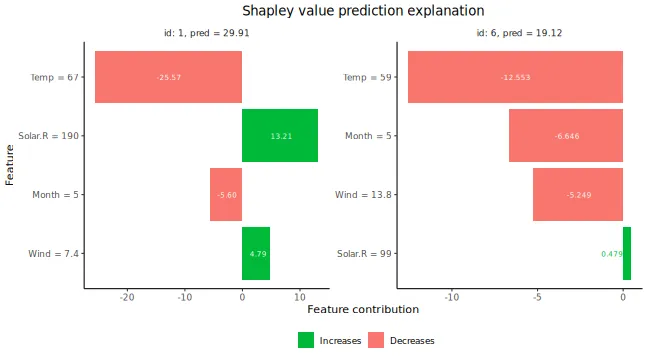
There are multiple plot options specified by the
plot_type argument in plot. The
waterfall option shows the changes in the prediction score
due to each feature’s contribution (their Shapley values):
There are multiple plot options specified by the
plot_type argument in plot. The
waterfall option shows the changes in the prediction score
due to each feature’s contribution (their Shapley values):
plot(explanation, plot_type = "waterfall", index_x_explain = c(1, 6))
#> ℹ Showing 2 of 6 observations.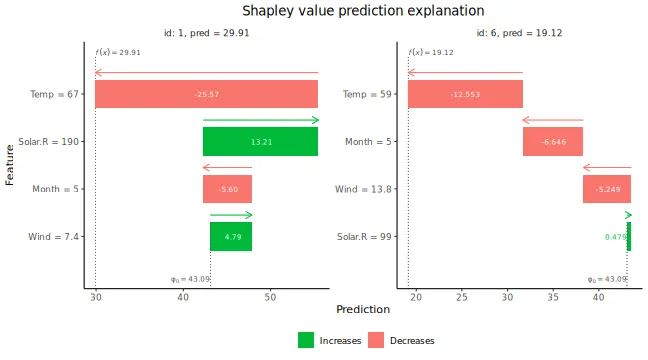
The other two plot options, "beeswarm" and
"scatter", can be useful when you have many observations
that you want to explain. For the purpose of illustration, we explain
the whole airquality dataset (including the training data)
for these plot types. The plot_type = "beeswarm" summarizes
the distribution of the Shapley values along the x-axis across all
features. Each point gives the Shapley value of a given instance, where
the points are colored by the feature value of that instance:
x_explain_many <- data[, ..x_var]
explanation_plot <- explain(
model = model,
x_explain = x_explain_many,
x_train = x_train,
approach = "empirical",
phi0 = p0,
seed = 1
)
#>
#> ── Starting `shapr::explain()` at 2025-12-20 11:31:40 ──────────────
#> ℹ `max_n_coalitions` is `NULL` or larger than `2^n_features = 16`,
#> and is therefore set to `2^n_features = 16`.
#>
#>
#> ── Explanation overview ──
#>
#>
#>
#> • Model class: <xgboost>
#>
#> • v(S) estimation class: Monte Carlo integration
#>
#> • Approach: empirical
#>
#> • Procedure: Non-iterative
#>
#> • Number of Monte Carlo integration samples: 1000
#>
#> • Number of feature-wise Shapley values: 4
#>
#> • Number of observations to explain: 111
#>
#> • Computations (temporary) saved at:
#> '/tmp/RtmpP6cesG/shapr_obj_781db3b09e7b8.rds'
#>
#>
#>
#> ── Main computation started ──
#>
#>
#>
#> ℹ Using 16 of 16 coalitions.
plot(explanation_plot, plot_type = "beeswarm")
#> ℹ Showing 10 of 111 observations.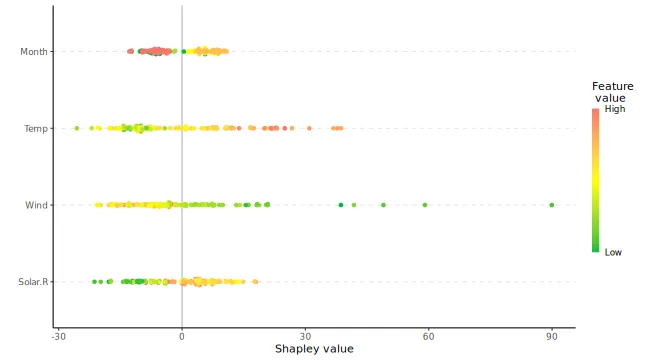
The plot_type = "scatter" plots the feature values on
the x-axis and Shapley values on the y-axis, as well as (optionally) a
background scatter_hist showing the distribution of the feature
data:
plot(explanation_plot, plot_type = "scatter", scatter_hist = TRUE)
#> ℹ Showing 10 of 111 observations.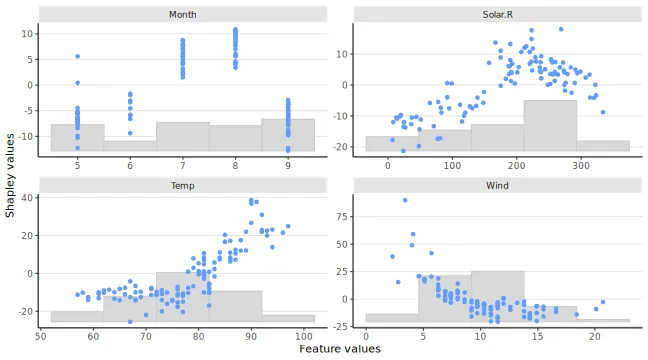
We can use mixed (i.e., continuous, categorical, ordinal) data with
ctree or vaeac. Use ctree with
mixed data in the following manner:
# convert the month variable to a factor
data[, Month_factor := as.factor(Month)]
data_train_cat <- data[-ind_x_explain, ]
data_explain_cat <- data[ind_x_explain, ]
x_var_cat <- c("Solar.R", "Wind", "Temp", "Month_factor")
x_train_cat <- data_train_cat[, ..x_var_cat]
x_explain_cat <- data_explain_cat[, ..x_var_cat]
# Fitting an lm model here as xgboost does not handle categorical features directly
# (workaround in example below)
lm_formula <- as.formula(paste0(y_var, " ~ ", paste0(x_var_cat, collapse = " + ")))
model_lm_cat <- lm(lm_formula, data_train_cat)
p0 <- mean(y_train)
explanation_lm_cat <- explain(
model = model_lm_cat,
x_explain = x_explain_cat,
x_train = x_train_cat,
approach = "ctree",
phi0 = p0,
seed = 1
)
#>
#> ── Starting `shapr::explain()` at 2025-12-20 11:31:48 ──────────────
#> ℹ `max_n_coalitions` is `NULL` or larger than `2^n_features = 16`,
#> and is therefore set to `2^n_features = 16`.
#>
#>
#> ── Explanation overview ──
#>
#>
#>
#> • Model class: <lm>
#>
#> • v(S) estimation class: Monte Carlo integration
#>
#> • Approach: ctree
#>
#> • Procedure: Non-iterative
#>
#> • Number of Monte Carlo integration samples: 1000
#>
#> • Number of feature-wise Shapley values: 4
#>
#> • Number of observations to explain: 6
#>
#> • Computations (temporary) saved at:
#> '/tmp/RtmpP6cesG/shapr_obj_781db85a8220.rds'
#>
#>
#>
#> ── Main computation started ──
#>
#>
#>
#> ℹ Using 16 of 16 coalitions.
# Plot the resulting explanations for observations 1 and 6, excluding
# the no-covariate effect
plot(explanation_lm_cat, bar_plot_phi0 = FALSE, index_x_explain = c(1, 6))
#> ℹ Showing 2 of 6 observations.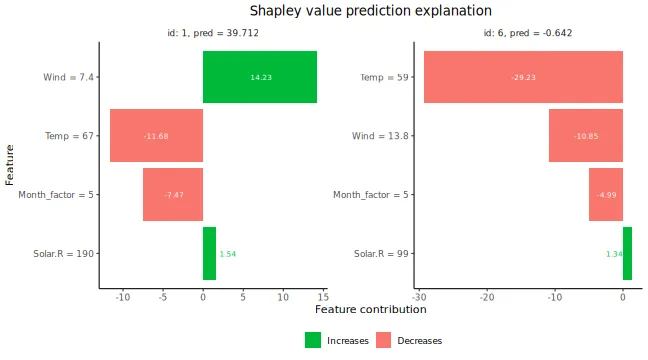
We can specify parameters used to build the conditional inference trees in the following manner. The default values are based on Hothorn, Hornik, and Zeileis (2006).
# Use the conditional inference tree approach
# We can specify parameters used to build trees by specifying mincriterion,
# minsplit, minbucket
explanation_ctree <- explain(
model = model_lm_cat,
x_explain = x_explain_cat,
x_train = x_train_cat,
approach = "ctree",
phi0 = p0,
seed = 1,
ctree.mincriterion = 0.80,
ctree.minsplit = 20,
ctree.minbucket = 20
)
#>
#> ── Starting `shapr::explain()` at 2025-12-20 11:31:50 ──────────────
#> ℹ `max_n_coalitions` is `NULL` or larger than `2^n_features = 16`,
#> and is therefore set to `2^n_features = 16`.
#>
#>
#> ── Explanation overview ──
#>
#>
#>
#> • Model class: <lm>
#>
#> • v(S) estimation class: Monte Carlo integration
#>
#> • Approach: ctree
#>
#> • Procedure: Non-iterative
#>
#> • Number of Monte Carlo integration samples: 1000
#>
#> • Number of feature-wise Shapley values: 4
#>
#> • Number of observations to explain: 6
#>
#> • Computations (temporary) saved at:
#> '/tmp/RtmpP6cesG/shapr_obj_781db8a512f9.rds'
#>
#>
#>
#> ── Main computation started ──
#>
#>
#>
#> ℹ Using 16 of 16 coalitions.
# Default parameters (based on (Hothorn, 2006)) are:
# mincriterion = 0.95
# minsplit = 20
# minbucket = 7If all features are categorical, one may use the categorical approach as follows:
# For the sake of illustration, convert ALL features to factors
data[, Solar.R_factor := as.factor(cut(Solar.R, 10))]
data[, Wind_factor := as.factor(cut(Wind, 3))]
data[, Temp_factor := as.factor(cut(Temp, 2))]
data[, Month_factor := as.factor(Month)]
data_train_all_cat <- data[-ind_x_explain, ]
data_explain_all_cat <- data[ind_x_explain, ]
x_var_all_cat <- c("Solar.R_factor", "Wind_factor", "Temp_factor", "Month_factor")
x_train_all_cat <- data_train_all_cat[, ..x_var_all_cat]
x_explain_all_cat <- data_explain_all_cat[, ..x_var_all_cat]
# Fit an lm model here
lm_formula_all_cat <- as.formula(paste0(y_var, " ~ ", paste0(x_var_all_cat, collapse = " + ")))
model_lm_all_cat <- lm(lm_formula_all_cat, data_train_all_cat)
explanation_cat_method <- explain(
model = model_lm_all_cat,
x_explain = x_explain_all_cat,
x_train = x_train_all_cat,
approach = "categorical",
phi0 = p0,
seed = 1
)
#>
#> ── Starting `shapr::explain()` at 2025-12-20 11:31:50 ──────────────
#> ℹ `max_n_coalitions` is `NULL` or larger than `2^n_features = 16`,
#> and is therefore set to `2^n_features = 16`.
#>
#>
#> ── Explanation overview ──
#>
#>
#>
#> • Model class: <lm>
#>
#> • v(S) estimation class: Monte Carlo integration
#>
#> • Approach: categorical
#>
#> • Procedure: Non-iterative
#>
#> • Number of Monte Carlo integration samples: 1000
#>
#> • Number of feature-wise Shapley values: 4
#>
#> • Number of observations to explain: 6
#>
#> • Computations (temporary) saved at:
#> '/tmp/RtmpP6cesG/shapr_obj_781db22df6699.rds'
#>
#>
#>
#> ── Main computation started ──
#>
#>
#>
#> ℹ Using 16 of 16 coalitions.Shapley values can be used to explain any predictive model. For
predictive models taking time series as input,
approach='timeseries' can be used. In such models, joint
behavior of consecutive time points is often more important for the
outcome than the single time points. Therefore, it makes sense to derive
Shapley value segments of the time series instead of for each single
time point. In shapr this can be achieved through the
group attribute. Other optional parameters of
approach='timeseries' are
timeseries.fixed_sigma and timeseries.bounds
(a vector indicating upper and lower bounds of the time series if
necessary).
# Simulate time series data with AR(1)-structure
set.seed(1)
data_ts <- data.frame(matrix(NA, ncol = 41, nrow = 4))
for (n in 1:100) {
set.seed(n)
e <- rnorm(42, mean = 0, sd = 1)
m_1 <- 0
for (i in 2:length(e)) {
m_1[i] <- 1 + 0.8 * m_1[i - 1] + e[i]
}
data_ts[n, ] <- m_1[-1]
}
data_ts <- data.table::as.data.table(data_ts)
x_var_ts <- paste0("X", 1:40)
y_var_ts <- "X41"
ind_x_explain <- 1:6
data_ts_train <- data_ts[-ind_x_explain]
# Creating a predictive model (for illustration just predicting the next point in the time series with a linear model)
lm_ts_formula <- as.formula(X41 ~ .)
model_lm_ts <- lm(lm_ts_formula, data_ts_train)
x_explain_ts <- data_ts[ind_x_explain, ..x_var_ts]
x_train_ts <- data_ts[-ind_x_explain, ..x_var_ts]
# Splitting the time series into 4 segments
group_ts <- list(
S1 = paste0("X", 1:10),
S2 = paste0("X", 11:20),
S3 = paste0("X", 21:30),
S4 = paste0("X", 31:40)
)
p0_ts <- mean(unlist(data_ts_train[, ..y_var_ts]))
explanation_timeseries <- explain(
model = model_lm_ts,
x_explain = x_explain_ts,
x_train = x_train_ts,
approach = "timeseries",
phi0 = p0_ts,
seed = 1,
group = group_ts
)
#>
#> ── Starting `shapr::explain()` at 2025-12-20 11:31:51 ──────────────
#> ℹ `max_n_coalitions` is `NULL` or larger than `2^n_groups = 16`,
#> and is therefore set to `2^n_groups = 16`.
#>
#>
#> ── Explanation overview ──
#>
#>
#>
#> • Model class: <lm>
#>
#> • v(S) estimation class: Monte Carlo integration
#>
#> • Approach: timeseries
#>
#> • Procedure: Non-iterative
#>
#> • Number of Monte Carlo integration samples: 1000
#>
#> • Number of group-wise Shapley values: 4
#>
#> • Feature groups: S1: {"X1", "X2", "X3", "X4", "X5", "X6", "X7",
#> "X8", "X9", "X10"}; S2: {"X11", "X12", "X13", "X14", "X15", "X16",
#> "X17", "X18", "X19", "X20"}; S3: {"X21", "X22", "X23", "X24",
#> "X25", "X26", "X27", "X28", "X29", "X30"}; S4: {"X31", "X32",
#> "X33", "X34", "X35", "X36", "X37", "X38", "X39", "X40"}
#>
#> • Number of observations to explain: 6
#>
#> • Computations (temporary) saved at:
#> '/tmp/RtmpP6cesG/shapr_obj_781db5f611a3c.rds'
#>
#>
#>
#> ── Main computation started ──
#>
#>
#>
#> ℹ Using 16 of 16 coalitions.MSEv evaluation criterion
We can use the criterion proposed by Frye et al. (2021), and later used by, e.g., Olsen et al. (2022) and Olsen et al. (2024), to evaluate and rank the approaches/methods. The is given by
where is the estimated contribution function using method and , i.e., we have removed the empty () and the grand combinations () as they are method independent. Meaning that these two combinations do not influence the ranking of the methods as the methods are not used to compute the contribution function for them.
The motivation behind the criterion is that can be decomposed as
see Appendix A in Covert, Lundberg, and Lee (2020). The first term on the right-hand side of the equation above can be estimated by , while the second term is a fixed (unknown) constant not influenced by the approach . Thus, a low value of indicates that the estimated contribution function is closer to the true counterpart than a high value.
In shapr, we allow for weighting the combinations in the
evaluation criterion either uniformly or by using the corresponding
Shapley kernel weights (or the sampling frequencies when sampling of
combinations is used). This is determined by the logical parameter
MSEv_uniform_comb_weights in the explain()
function, and the default is to do uniform weighting, that is,
MSEv_uniform_comb_weights = TRUE.
Advantage:
An advantage of the criterion is that is not involved. Thus, we can apply it as an evaluation criterion to real-world data sets where the true Shapley values are unknown.
Disadvantages:
First, we can only use the criterion to rank the methods and not assess their closeness to the optimum since the minimum value of the criterion is unknown. Second, the criterion evaluates the contribution functions and not the Shapley values.
Olsen et al. (2024) observed a relatively linear relationship between the criterion and the mean absolute error between the true and estimated Shapley values in extensive simulation studies where the true Shapley values were known. That is, a method that achieves a low score also tends to obtain a low score, and vice versa.
Confidence intervals
The
criterion can be written as
.
We can therefore use the central limit theorem to compute an approximate
confidence interval for the
criterion. We have that
is a
approximate confidence interval for the evaluation criterion, where
is the
percentile of the
distribution. Note that
should be large (rule of thumb is at least
)
for the central limit theorem to be valid. The quantities
and
are returned by the explain() function in the
MSEv list of data tables. We can also compute similar
approximate confidence interval for
criterion for each combination/coalition when only averaging over the
observations. However, it does not make sense in the other direction,
i.e., when only averaging over the combinations for each observation, as
each combination is a different prediction tasks.
MSEv examples
Start by explaining the predictions by using different methods and combining them into lists.
# We use more explicands here for more stable confidence intervals
ind_x_explain_many <- 1:25
x_train <- data[-ind_x_explain_many, ..x_var]
y_train <- data[-ind_x_explain_many, get(y_var)]
x_explain <- data[ind_x_explain_many, ..x_var]
# Fitting a basic xgboost model to the training data
model <- xgboost::xgboost(
x = x_train,
y = y_train,
nround = 20,
verbosity = 0
)
# Specifying the phi_0, i.e. the expected prediction without any features
p0 <- mean(y_train)
# Independence approach
explanation_independence <- explain(
model = model,
x_explain = x_explain,
x_train = x_train,
approach = "independence",
phi0 = p0,
seed = 1,
n_MC_samples = 1e2,
MSEv_uniform_comb_weights = TRUE
)
#>
#> ── Starting `shapr::explain()` at 2025-12-20 11:31:58 ──────────────
#> ℹ `max_n_coalitions` is `NULL` or larger than `2^n_features = 16`,
#> and is therefore set to `2^n_features = 16`.
#>
#>
#> ── Explanation overview ──
#>
#>
#>
#> • Model class: <xgboost>
#>
#> • v(S) estimation class: Monte Carlo integration
#>
#> • Approach: independence
#>
#> • Procedure: Non-iterative
#>
#> • Number of Monte Carlo integration samples: 100
#>
#> • Number of feature-wise Shapley values: 4
#>
#> • Number of observations to explain: 25
#>
#> • Computations (temporary) saved at:
#> '/tmp/RtmpP6cesG/shapr_obj_781db10d41e19.rds'
#>
#>
#>
#> ── Main computation started ──
#>
#>
#>
#> ℹ Using 16 of 16 coalitions.
# Empirical approach
explanation_empirical <- explain(
model = model,
x_explain = x_explain,
x_train = x_train,
approach = "empirical",
phi0 = p0,
seed = 1,
n_MC_samples = 1e2,
MSEv_uniform_comb_weights = TRUE
)
#>
#> ── Starting `shapr::explain()` at 2025-12-20 11:31:59 ──────────────
#> ℹ `max_n_coalitions` is `NULL` or larger than `2^n_features = 16`,
#> and is therefore set to `2^n_features = 16`.
#> ── Explanation overview ──
#>
#> • Model class: <xgboost>
#> • v(S) estimation class: Monte Carlo integration
#> • Approach: empirical
#> • Procedure: Non-iterative
#> • Number of Monte Carlo integration samples: 100
#> • Number of feature-wise Shapley values: 4
#> • Number of observations to explain: 25
#> • Computations (temporary) saved at:
#> '/tmp/RtmpP6cesG/shapr_obj_781db14d8ed52.rds'
#>
#> ── Main computation started ──
#>
#> ℹ Using 16 of 16 coalitions.
# Gaussian 1e1 approach
explanation_gaussian_1e1 <- explain(
model = model,
x_explain = x_explain,
x_train = x_train,
approach = "gaussian",
phi0 = p0,
seed = 1,
n_MC_samples = 1e1,
MSEv_uniform_comb_weights = TRUE
)
#>
#> ── Starting `shapr::explain()` at 2025-12-20 11:32:03 ──────────────
#> ℹ `max_n_coalitions` is `NULL` or larger than `2^n_features = 16`,
#> and is therefore set to `2^n_features = 16`.
#> ── Explanation overview ──
#>
#> • Model class: <xgboost>
#> • v(S) estimation class: Monte Carlo integration
#> • Approach: gaussian
#> • Procedure: Non-iterative
#> • Number of Monte Carlo integration samples: 10
#> • Number of feature-wise Shapley values: 4
#> • Number of observations to explain: 25
#> • Computations (temporary) saved at:
#> '/tmp/RtmpP6cesG/shapr_obj_781db6827e874.rds'
#>
#> ── Main computation started ──
#>
#> ℹ Using 16 of 16 coalitions.
# Gaussian 1e2 approach
explanation_gaussian_1e2 <- explain(
model = model,
x_explain = x_explain,
x_train = x_train,
approach = "gaussian",
phi0 = p0,
seed = 1,
n_MC_samples = 1e2,
MSEv_uniform_comb_weights = TRUE
)
#>
#> ── Starting `shapr::explain()` at 2025-12-20 11:32:04 ──────────────
#> ℹ `max_n_coalitions` is `NULL` or larger than `2^n_features = 16`,
#> and is therefore set to `2^n_features = 16`.
#> ── Explanation overview ──
#>
#> • Model class: <xgboost>
#> • v(S) estimation class: Monte Carlo integration
#> • Approach: gaussian
#> • Procedure: Non-iterative
#> • Number of Monte Carlo integration samples: 100
#> • Number of feature-wise Shapley values: 4
#> • Number of observations to explain: 25
#> • Computations (temporary) saved at:
#> '/tmp/RtmpP6cesG/shapr_obj_781db6e2c14f0.rds'
#>
#> ── Main computation started ──
#>
#> ℹ Using 16 of 16 coalitions.
# Combined approach
explanation_combined <- explain(
model = model,
x_explain = x_explain,
x_train = x_train,
approach = c("gaussian", "empirical", "independence"),
phi0 = p0,
seed = 1,
n_MC_samples = 1e2,
MSEv_uniform_comb_weights = TRUE
)
#>
#> ── Starting `shapr::explain()` at 2025-12-20 11:32:04 ──────────────
#> ℹ `max_n_coalitions` is `NULL` or larger than `2^n_features = 16`,
#> and is therefore set to `2^n_features = 16`.
#> ── Explanation overview ──
#>
#> • Model class: <xgboost>
#> • v(S) estimation class: Monte Carlo integration
#> • Approach: gaussian, empirical, and independence
#> • Procedure: Non-iterative
#> • Number of Monte Carlo integration samples: 100
#> • Number of feature-wise Shapley values: 4
#> • Number of observations to explain: 25
#> • Computations (temporary) saved at:
#> '/tmp/RtmpP6cesG/shapr_obj_781db6304368e.rds'
#>
#> ── Main computation started ──
#>
#> ℹ Using 16 of 16 coalitions.
# Create a list of explanations with names
explanation_list_named <- list(
"Ind." = explanation_independence,
"Emp." = explanation_empirical,
"Gaus. 1e1" = explanation_gaussian_1e1,
"Gaus. 1e2" = explanation_gaussian_1e2,
"Combined" = explanation_combined
)We can then compare the different approaches by creating plots of the evaluation criterion.
# Create the MSEv plots with approximate 95% confidence intervals
MSEv_plots <- plot_MSEv_eval_crit(explanation_list_named,
plot_type = c("overall", "comb", "explicand"),
CI_level = 0.95
)
#> ℹ Showing 10 of 25 observations.
# 5 plots are made
names(MSEv_plots)
#> [1] "MSEv_explicand_bar" "MSEv_explicand_line_point"
#> [3] "MSEv_coalition_bar" "MSEv_coalition_line_point"
#> [5] "MSEv_bar"The main plot if interest is the MSEv_bar, which
displays the
evaluation criterion for each method averaged over both the
combinations/coalitions and test observations/explicands. However, we
can also look at the other plots where we have only averaged over the
observations or the combinations (both as bar and line plots).
# The main plot of the overall MSEv averaged over both the combinations and observations
MSEv_plots$MSEv_bar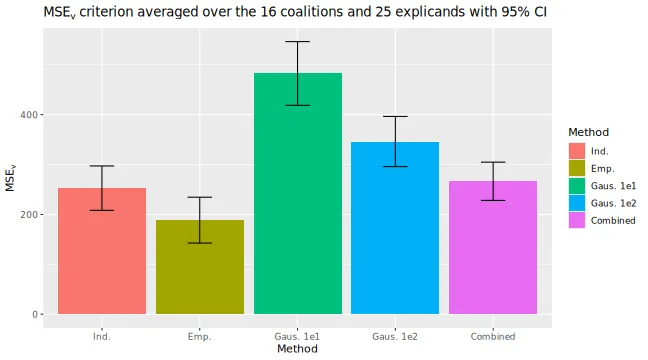
# The MSEv averaged over only the explicands for each combinations
MSEv_plots$MSEv_combination_bar
#> NULL
# The MSEv averaged over only the combinations for each observation/explicand
MSEv_plots$MSEv_explicand_bar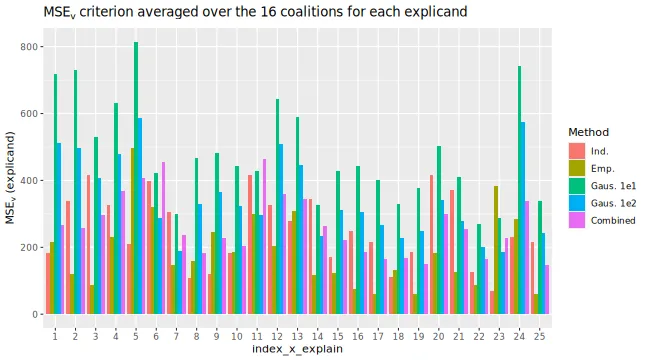
# To see which coalition S each of the `id_combination` corresponds to,
# i.e., which features that are conditions on.
explanation_list_named[[1]]$MSEv$MSEv_combination[, c("id_combination", "features")]
#> NULLWe can specify the index_x_explain and
id_combination parameters in
plot_MSEv_eval_crit() to only plot certain test
observations and combinations, respectively.
# We can specify which test observations or combinations to plot
plot_MSEv_eval_crit(explanation_list_named,
plot_type = "explicand",
index_x_explain = c(1, 3:4, 6),
CI_level = 0.95
)$MSEv_explicand_bar
#> ℹ Showing 4 of 25 observations.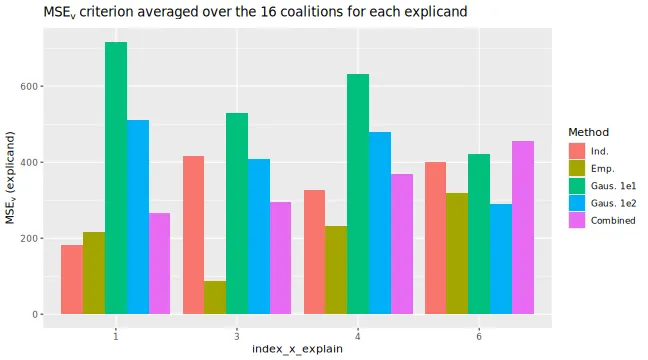
plot_MSEv_eval_crit(explanation_list_named,
plot_type = "comb",
id_coalition = c(3, 4, 9, 13:15),
CI_level = 0.95
)$MSEv_combination_bar
#> ℹ Showing 10 of 25 observations.
#> NULLWe can also alter the plots design-wise as we do in the code below.
bar_text_n_decimals <- 1
plot_MSEv_eval_crit(explanation_list_named) +
ggplot2::scale_x_discrete(limits = rev(levels(MSEv_plots$MSEv_bar$data$Method))) +
ggplot2::coord_flip() +
ggplot2::scale_fill_brewer(palette = "Paired") +
ggplot2::theme_minimal() + # This must be set before other theme calls
ggplot2::theme(
plot.title = ggplot2::element_text(size = 10),
legend.position = "bottom"
) +
ggplot2::geom_text(
ggplot2::aes(label = sprintf(
paste("%.", sprintf("%d", bar_text_n_decimals), "f", sep = ""),
round(MSEv, bar_text_n_decimals)
)),
vjust = -0.35, # This number might need altering for different plots sizes
hjust = 1.1, # This number might need altering for different plots sizes
color = "black",
position = ggplot2::position_dodge(0.9),
size = 4
)
#> ℹ Showing 10 of 25 observations.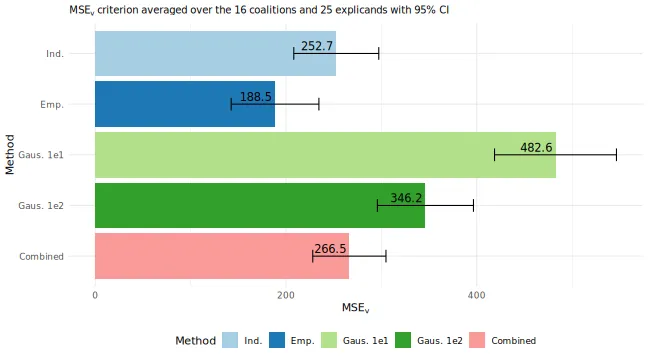
Iterative estimation
Iterative estimation is the default when computing Shapley values
with six or more features (or feature groups), and can always be
manually overridden by setting iterative = FALSE in the
explain() function. The idea behind iterative estimation is
to estimate sufficiently accurate Shapley value estimates faster. First,
an initial number of coalitions is sampled, then, bootsrapping is used
to estimate the variance of the Shapley values. A convergence criterion
is used to determine if the variances of the Shapley values are
sufficiently small. If the variances are too high, we estimate the
number of required samples to reach convergence, and thereby add more
coalitions. The process is repeated until the variances are below the
threshold. Specifics related to the iterative process and convergence
criterion are set through iterative_args argument.
The convergence criterion we use is adopted from Covert and Lee (2021), and slightly modified to work for multiple observations
where is the Shapley value of feature for observation , and is the its (bootstrap) estimated standard deviation. The default value of is 0.02. Below we provide some examples of how to use the iterative estimation procedure.
library(xgboost)
library(data.table)
data("airquality")
data <- data.table::as.data.table(airquality)
data <- data[complete.cases(data), ]
x_var <- c("Solar.R", "Wind", "Temp", "Month", "Day")
y_var <- "Ozone"
ind_x_explain <- 1:6
x_train <- data[-ind_x_explain, ..x_var]
y_train <- data[-ind_x_explain, get(y_var)]
x_explain <- data[ind_x_explain, ..x_var]
# Set seed for reproducibility
set.seed(123)
# Fitting a basic xgboost model to the training data
model <- xgboost::xgboost(
x = x_train,
y = y_train,
nround = 20,
verbosity = 0
)
# Specifying the phi_0, i.e. the expected prediction without any features
p0 <- mean(y_train)
# Explanation with iterative computation
ex <- explain(
model = model,
x_explain = x_explain,
x_train = x_train,
approach = "gaussian",
phi0 = p0,
seed = 1,
iterative = TRUE,
iterative_args = list(convergence_tol = 0.1)
)
#>
#> ── Starting `shapr::explain()` at 2025-12-20 11:32:12 ──────────────
#> ℹ `max_n_coalitions` is `NULL` or larger than `2^n_features = 32`,
#> and is therefore set to `2^n_features = 32`.
#>
#>
#> ── Explanation overview ──
#>
#>
#>
#> • Model class: <xgboost>
#>
#> • v(S) estimation class: Monte Carlo integration
#>
#> • Approach: gaussian
#>
#> • Procedure: Iterative
#>
#> • Number of Monte Carlo integration samples: 1000
#>
#> • Number of feature-wise Shapley values: 5
#>
#> • Number of observations to explain: 6
#>
#> • Computations (temporary) saved at:
#> '/tmp/RtmpP6cesG/shapr_obj_781db520e6853.rds'
#>
#>
#>
#> ── Iterative computation started ──
#>
#>
#>
#> ── Iteration 1 ─────────────────────────────────────────────────────
#>
#> ℹ Using 6 of 32 coalitions, 6 new.
#>
#>
#>
#> ── Iteration 2 ─────────────────────────────────────────────────────
#>
#> ℹ Using 8 of 32 coalitions, 2 new.
#>
#>
#>
#> ── Iteration 3 ─────────────────────────────────────────────────────
#>
#> ℹ Using 12 of 32 coalitions, 4 new.
#>
#>
#>
#> ── Iteration 4 ─────────────────────────────────────────────────────
#>
#> ℹ Using 14 of 32 coalitions, 2 new.Summary, Printing, and Result Extraction
As shown above, print(explain_object) displays the
estimated Shapley values from an object created using
explain(). This is the default behavior of the
print() method for shapr objects.
However, print.shapr also includes a what
argument that controls what is printed. This allows users to also
display: - the standard deviations arising from coalition sampling
(what = "shapley_sd"), and - variants of the MSEv criterion introduced above, using
what = "MSEv", "MSEv_explicand", or
"MSEv_coalition".
The summary(explain_object) function returns a
summary.shapr object containing a complete list of summary
components. When called interactively without assignment (or explicitly
printed with print()), it displays a nicely formatted
summary to the console. When assigned to a variable, the formatted
output is suppressed, but the returned object can be used to extract
individual components later. Internally, summary.shapr
calls get_results(), which produces this full set of
components, including: the parameters used, intermediate Shapley value
estimates (and their standard deviations), estimates of all
,
and more. See ?get_results for a full overview of the
returned output.
Below, we illustrate these capabilities using the iterative
explanation object ex computed above.
# Uses the object ex to illustrate printing and summary functionality
print(ex) # Prints the estimated Shapley values by default
#> explain_id none Solar.R Wind Temp Month Day
#> <int> <num> <num> <num> <num> <num> <num>
#> 1: 1 43.1 1.43 4.75 -20.3 -5.46 0.711
#> 2: 2 43.1 -3.52 -1.31 -16.8 -5.50 1.991
#> 3: 3 43.1 -1.17 -7.83 -11.2 -4.78 2.224
#> 4: 4 43.1 9.53 -7.07 -16.6 -4.46 0.247
#> 5: 5 43.1 8.43 -1.03 -22.1 -4.83 0.989
#> 6: 6 43.1 -2.66 -7.17 -12.4 -5.18 0.812
print(ex, what = "shapley_sd") # Prints the estimated standard deviations of the Shapley values
#> explain_id none Solar.R Wind Temp Month Day
#> <int> <num> <num> <num> <num> <num> <num>
#> 1: 1 0 1.385 2.697 0.720 2.740 0.859
#> 2: 2 0 0.797 1.224 0.550 1.202 0.602
#> 3: 3 0 1.278 1.292 0.791 1.005 0.777
#> 4: 4 0 3.754 2.955 1.078 1.791 1.347
#> 5: 5 0 2.310 1.904 0.620 1.632 0.718
#> 6: 6 0 1.024 0.963 0.654 0.751 0.614
print(ex, what = "MSEv") # Prints the MSEv evaluation criterion
#> MSEv MSEv_sd
#> <num> <num>
#> 1: 176 12.6
# When called without assignment, summary() prints formatted output to console
summary(ex)
#>
#> ── Summary of Shapley value explanation ────────────────────────────────
#> • Computed with `shapr::explain()` in 2.9 seconds, started 2025-12-20
#> 11:32:12
#> • Model class: <xgboost>
#> • v(S) estimation class: Monte Carlo integration
#> • Approach: gaussian
#> • Procedure: Iterative
#> • Number of Monte Carlo integration samples: 1000
#> • Number of feature-wise Shapley values: 5
#> • Number of observations to explain: 6
#> • Number of coalitions used: 14 (of total 32)
#> • Computations (temporary) saved at:
#> '/tmp/RtmpP6cesG/shapr_obj_781db520e6853.rds'
#>
#> ── Convergence info
#> ✔ Iterative Shapley value estimation stopped at 14 coalitions after 4 iterations, due to:
#> Standard deviation convergence threshold (0.1) reached: 0.087!
#>
#> ── Estimated Shapley values (sd in parentheses)
#> explain_id none Solar.R Wind Temp Month
#> <int> <char> <char> <char> <char> <char>
#> 1: 1 43.09 (0) 1.43 (1.39) 4.75 (2.70) -20.31 (0.72) -5.46 (2.74)
#> 2: 2 43.09 (0) -3.52 (0.80) -1.31 (1.22) -16.77 (0.55) -5.50 (1.20)
#> 3: 3 43.09 (0) -1.17 (1.28) -7.83 (1.29) -11.19 (0.79) -4.78 (1.01)
#> 4: 4 43.09 (0) 9.53 (3.75) -7.07 (2.96) -16.64 (1.08) -4.46 (1.79)
#> 5: 5 43.09 (0) 8.43 (2.31) -1.03 (1.90) -22.15 (0.62) -4.83 (1.63)
#> 6: 6 43.09 (0) -2.66 (1.02) -7.17 (0.96) -12.44 (0.65) -5.18 (0.75)
#> Day
#> <char>
#> 1: 0.71 (0.86)
#> 2: 1.99 (0.60)
#> 3: 2.22 (0.78)
#> 4: 0.25 (1.35)
#> 5: 0.99 (0.72)
#> 6: 0.81 (0.61)
#>
#>
#> ── Estimated MSEv
#>
#> Estimated MSE of v(S) = 176 (with sd = 13)
# When assigned, it returns a summary.shapr object with all components available for extraction
summary_ex <- summary(ex) # print(summary_ex) also provides the formatted output
summary_ex$shapley_est # The estimated Shapley values
#> explain_id none Solar.R Wind Temp Month Day
#> <int> <num> <num> <num> <num> <num> <num>
#> 1: 1 43.086 1.4286 4.7521 -20.315 -5.4611 0.71096
#> 2: 2 43.086 -3.5184 -1.3111 -16.773 -5.5042 1.99097
#> 3: 3 43.086 -1.1714 -7.8251 -11.193 -4.7817 2.22354
#> 4: 4 43.086 9.5350 -7.0722 -16.640 -4.4607 0.24681
#> 5: 5 43.086 8.4310 -1.0295 -22.146 -4.8326 0.98870
#> 6: 6 43.086 -2.6600 -7.1738 -12.442 -5.1770 0.81207
summary_ex$shapley_sd # The estimated standard deviations of the Shapley values
#> explain_id none Solar.R Wind Temp Month Day
#> <int> <num> <num> <num> <num> <num> <num>
#> 1: 1 0 1.38523 2.6970 0.71961 2.73982 0.85914
#> 2: 2 0 0.79651 1.2244 0.54988 1.20189 0.60213
#> 3: 3 0 1.27829 1.2924 0.79077 1.00546 0.77693
#> 4: 4 0 3.75405 2.9552 1.07837 1.79060 1.34699
#> 5: 5 0 2.30995 1.9036 0.61982 1.63183 0.71767
#> 6: 6 0 1.02353 0.9635 0.65412 0.75063 0.61376
summary_ex$timing_summary$total_time_secs # Total computation time in seconds
#> [1] 2.9332
summary_ex$parameters$n_MC_samples # Number of Monte Carlo samples used
#> [1] 1000
summary_ex$parameters$gaussian.mu # Estimated mean vector (Gaussian approach)
#> [1] 184.2381 9.9181 78.4381 7.3429 16.6190
summary_ex$parameters$gaussian.cov_mat # Estimated covariance matrix (Gaussian approach)
#> Solar.R Wind Temp Month Day
#> Solar.R 8378.0678 -41.1072 284.0966 -9.1882 -42.7738
#> Wind -41.1072 13.0369 -17.3205 -1.0274 1.7137
#> Temp 284.0966 -17.3205 86.6908 4.4734 -16.0623
#> Month -9.1882 -1.0274 4.4734 1.9967 -1.7143
#> Day -42.7738 1.7137 -16.0623 -1.7143 71.3535
# Alternatively, use get_results() to get the same components without printing the summary
res_ex <- get_results(ex)
# You may also extract individual summary components directly using get_results()
get_results(ex, what = "shapley_sd")
#> explain_id none Solar.R Wind Temp Month Day
#> <int> <num> <num> <num> <num> <num> <num>
#> 1: 1 0 1.38523 2.6970 0.71961 2.73982 0.85914
#> 2: 2 0 0.79651 1.2244 0.54988 1.20189 0.60213
#> 3: 3 0 1.27829 1.2924 0.79077 1.00546 0.77693
#> 4: 4 0 3.75405 2.9552 1.07837 1.79060 1.34699
#> 5: 5 0 2.30995 1.9036 0.61982 1.63183 0.71767
#> 6: 6 0 1.02353 0.9635 0.65412 0.75063 0.61376
get_results(ex, what = "dt_vS")
#> Index: <id_coalition>
#> id_coalition p_hat1_1 p_hat1_2 p_hat1_3 p_hat1_4 p_hat1_5 p_hat1_6
#> <num> <num> <num> <num> <num> <num> <num>
#> 1: 1 43.086 43.086 43.086 43.086 43.086 43.086
#> 2: 2 20.672 23.742 25.557 18.441 20.289 18.358
#> 3: 3 49.810 48.921 48.867 48.283 47.242 47.945
#> 4: 4 46.513 38.602 41.850 57.125 56.020 34.916
#> 5: 5 40.838 36.789 24.698 23.180 34.346 19.999
#> 6: 6 36.619 36.375 36.366 36.024 35.761 35.990
#> 7: 7 20.501 24.199 25.712 17.099 19.566 16.705
#> 8: 8 20.906 24.090 26.848 23.487 25.621 19.646
#> 9: 9 27.235 18.286 18.735 26.061 24.861 18.078
#> 10: 10 41.170 29.508 23.319 31.382 43.829 16.671
#> 11: 11 40.285 30.598 23.124 30.100 44.174 15.267
#> 12: 12 27.371 18.251 19.601 26.170 24.858 18.345
#> 13: 13 22.901 19.603 21.205 16.351 19.159 14.798
#> 14: 14 24.201 17.970 20.338 24.695 24.498 16.445Parallelization
The shapr package supports parallelization of the
Shapley value estimation process through the future
package. The parallelization is conducted over batches of
v(S)-values. We therefore start by describing this batch
computing.
Batch computation
The computational complexity of Shapley value based explanations
grows fast in the number of features, as the number of conditional
expectations one needs to estimate in the Shapley formula grows
exponentially. As outlined above, the estimating of
each of these conditional expectations is also computationally
expensive, typically requiring estimation of a conditional probability
distribution, followed by Monte Carlo integration. These computations
are not only heavy for the CPU, they also require a lot of memory (RAM),
which typically is a limited resource. By doing the most resource-hungry
computations (the computation of v(S)) in sequential batches with
different feature subsets
,
the memory usage can be significantly reduced. The user can control the
number of batches by setting the two arguments
extra_computation_args$max_batch_size (defaults to 10) and
extra_computation_args$min_n_batches (defaults to 10).
Parallelized computation
In addition to reducing the memory consumption, the batch computing
allows the computations within each batch to be performed in parallel.
The parallelization in shapr::explain() is handled by the
future_apply package which builds on the
future environment. These packages work on all OSes, allow
the user to decide the parallelization backend (multiple R processes or
forking), work directly with HPC clusters, and also supports progress
updates for the parallelized task via the associated
progressr package (see Verbosity and
progress updates).
Note that, since it takes some time to duplicate data into different
processes/machines when running in parallel, it is not always preferable
to run shapr::explain() in parallel, at least not with many
parallel sessions/workers. Parallelization also increases the memory
consumption proportionally, so you may want to limit the number of
workers for that reason too. Below is a basic example of a
parallelization with two workers.
library(future)
future::plan(multisession, workers = 2)
explanation_par <- explain(
model = model,
x_explain = x_explain,
x_train = x_train,
approach = "empirical",
phi0 = p0,
seed = 1
)
#>
#> ── Starting `shapr::explain()` at 2025-12-20 11:32:16 ──────────────
#> ℹ `max_n_coalitions` is `NULL` or larger than `2^n_features = 32`,
#> and is therefore set to `2^n_features = 32`.
#>
#>
#> ── Explanation overview ──
#>
#>
#>
#> • Model class: <xgboost>
#>
#> • v(S) estimation class: Monte Carlo integration
#>
#> • Approach: empirical
#>
#> • Procedure: Non-iterative
#>
#> • Number of Monte Carlo integration samples: 1000
#>
#> • Number of feature-wise Shapley values: 5
#>
#> • Number of observations to explain: 6
#>
#> • Computations (temporary) saved at:
#> '/tmp/RtmpP6cesG/shapr_obj_781db14b5b6c2.rds'
#>
#>
#>
#> ── Main computation started ──
#>
#>
#>
#> ℹ Using 32 of 32 coalitions.
future::plan(sequential) # To return to non-parallel computationVerbosity and progress updates
The verbose argument controls the verbosity of the
output while running explain(), and allows one or more of
the strings "basic", "progress",
"convergence", "shapley" and
"vS_details". "basic" (default) displays basic
information about the computation which is being performed,
"progress displays information about where in the
calculation process the function currently is,
"convergence" displays information on how close to
convergence the Shapley value estimates are (for iterative estimation),
"shapley" displays (intermediate) Shapley value estimates
and standard deviations + the final estimates, while
"vS_details" displays information about the
v(S) estimates for some of the approaches. If the user
wants no printout, the argument can be set to NULL.
In addition, progress updates for the computation of the
v(S) values are (optionally) provided through the R-package
progressr. This gives the user full control over the visual
appearance of these progress updates. The main reason for providing this
separate progress update feature is that it integrates seamlessly with
the parallelization framework future used by
shapr (see Parallelization), and
apparently is the only framework allowing progress updates also for
parallelized tasks. These progress updates can be used in combination
with, or independently of, the verbose argument.
These progress updates via progressr can be enabled for
the current R-session by running the command
progressr::handlers(local=TRUE), before calling
explain(). To use progress updates for only a single call
to explain(), one can wrap the call using
progressr::with_progress as follows:
progressr::with_progress({ shapr::explain() }) The default
appearance of the progress updates is a basic ASCII-based horizontal
progress bar. Other variants can be chosen by passing different strings
to progressr::handlers(), some of which require additional
packages. If you are using RStudio, the progress can be displayed
directly in the GUI with progressr::handlers('rstudio')
(requires the rstudioapi package). If you are running
Windows, you may use the pop-up GUI progress bar
progressr::handlers('handler_winprogressbar'). A wrapper
for progressbar of the flexible cli package, is also
available progressr::handlers('cli').
For a full list of all progression handlers and the customization
options available with progressr, see the
progressr vignette.
A full code example of using progressr with
shapr is shown below:
library(progressr)
progressr::handlers(global = TRUE)
handlers("cli")
# If no progression handler is specified, the txtprogressbar is used
# Other progression handlers:
# progressr::handlers('progress') # requires the 'progress' package
# progressr::handlers('rstudio') # requires the 'rstudioapi' package
# progressr::handlers('handler_winprogressbar') # Window only
ex_progress <- explain(
model = model,
x_explain = x_explain,
x_train = x_train,
approach = "empirical",
phi0 = p0,
seed = 1
)
# ■■■■■■■■■■■ 32% | Estimating v(S) ETA: 2sAdvanced usage
Combined approach
In addition to letting the user select one of the five aforementioned
approaches for estimating the conditional distribution of the data (i.e.
approach equals either "gaussian", "copula", "empirical", "ctree", "vaeac", "categorical") or
"timeseries", the package allows the user to combine the
given approaches. The 'regression_surrogate' and
'regression_separate approaches are not supported for the
combined approach. To simplify the usage, the flexibility is restricted
such that the same approach is used when conditioning on the same number
of features. This is also in line Aas, Jullum,
and Løland (2021, sec. 3.4).
This can be done by setting approach equal to a
character vector, where the length of the vector is one less than the
number of features in the model. Consider a situation where you have
trained a model that consists of 10 features, and you would like to use
the "empirical" approach when you condition on 1-3
features, the "copula" approach when you condition on 4-5
features, and the "gaussian" approach when conditioning on
6 or more features. This can be applied by simply passing
approach = c(rep("empirical", 3), rep("copula", 2), rep("gaussian", 4)),
i.e. approach[i] determines which method to use when
conditioning on i features. Conditioning on all features
needs no approach as that is given by the complete prediction itself,
and should thus not be part of the vector.
The code below exemplifies this approach for a case where there are
four features, using "empirical", "copula" and
"gaussian" when conditioning on respectively 1, 2 and 3
features.
library(xgboost)
library(data.table)
data("airquality")
data <- data.table::as.data.table(airquality)
data <- data[complete.cases(data), ]
x_var <- c("Solar.R", "Wind", "Temp", "Month")
y_var <- "Ozone"
ind_x_explain <- 1:6
x_train <- data[-ind_x_explain, ..x_var]
y_train <- data[-ind_x_explain, get(y_var)]
x_explain <- data[ind_x_explain, ..x_var]
# Set seed for reproducibility
set.seed(123)
# Fitting a basic xgboost model to the training data
model <- xgboost::xgboost(
x = x_train,
y = y_train,
nround = 20,
verbosity = 0
)
# Specifying the phi_0, i.e. the expected prediction without any features
p0 <- mean(y_train)
# Use the combined approach
explanation_combined <- explain(
model = model,
x_explain = x_explain,
x_train = x_train,
approach = c("empirical", "copula", "gaussian"),
phi0 = p0,
seed = 1
)
#>
#> ── Starting `shapr::explain()` at 2025-12-20 11:32:24 ──────────────
#> ℹ `max_n_coalitions` is `NULL` or larger than `2^n_features = 16`,
#> and is therefore set to `2^n_features = 16`.
#>
#>
#> ── Explanation overview ──
#>
#>
#>
#> • Model class: <xgboost>
#>
#> • v(S) estimation class: Monte Carlo integration
#>
#> • Approach: empirical, copula, and gaussian
#>
#> • Procedure: Non-iterative
#>
#> • Number of Monte Carlo integration samples: 1000
#>
#> • Number of feature-wise Shapley values: 4
#>
#> • Number of observations to explain: 6
#>
#> • Computations (temporary) saved at:
#> '/tmp/RtmpP6cesG/shapr_obj_781db2e416154.rds'
#>
#>
#>
#> ── Main computation started ──
#>
#>
#>
#> ℹ Using 16 of 16 coalitions.
# Plot the resulting explanations for observations 1 and 6, excluding
# the no-covariate effect
plot(explanation_combined, bar_plot_phi0 = FALSE, index_x_explain = c(1, 6))
#> ℹ Showing 2 of 6 observations.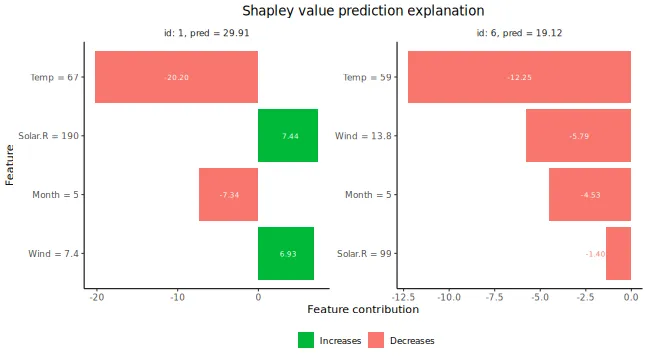
As a second example using "ctree" to condition on 1 and
2 features, and "empirical" when conditioning on 3
features:
# Use the combined approach
explanation_combined <- explain(
model = model,
x_explain = x_explain,
x_train = x_train,
approach = c("ctree", "ctree", "empirical"),
phi0 = p0,
seed = 1
)
#>
#> ── Starting `shapr::explain()` at 2025-12-20 11:32:26 ──────────────
#> ℹ `max_n_coalitions` is `NULL` or larger than `2^n_features = 16`,
#> and is therefore set to `2^n_features = 16`.
#>
#>
#> ── Explanation overview ──
#>
#>
#>
#> • Model class: <xgboost>
#>
#> • v(S) estimation class: Monte Carlo integration
#>
#> • Approach: ctree, ctree, and empirical
#>
#> • Procedure: Non-iterative
#>
#> • Number of Monte Carlo integration samples: 1000
#>
#> • Number of feature-wise Shapley values: 4
#>
#> • Number of observations to explain: 6
#>
#> • Computations (temporary) saved at:
#> '/tmp/RtmpP6cesG/shapr_obj_781dbb48bb2.rds'
#>
#>
#>
#> ── Main computation started ──
#>
#>
#>
#> ℹ Using 16 of 16 coalitions.Explain groups of features
In some cases, especially when the number of features is very large,
it may be more appropriate to explain predictions in terms of groups of
features instead of single features, see (Jullum,
Redelmeier, and Aas (2021)) for intuition and real-world
examples. Explaining predictions in terms of groups of features is very
easy using shapr:
# Define the feature groups
group_list <- list(
A = c("Temp", "Month"),
B = c("Wind", "Solar.R")
)
# Use the empirical approach
explanation_group <- explain(
model = model,
x_explain = x_explain,
x_train = x_train,
approach = "empirical",
phi0 = p0,
seed = 1,
group = group_list
)
#>
#> ── Starting `shapr::explain()` at 2025-12-20 11:32:28 ──────────────
#> ℹ `max_n_coalitions` is `NULL` or larger than `2^n_groups = 4`, and
#> is therefore set to `2^n_groups = 4`.
#>
#>
#> ── Explanation overview ──
#>
#>
#>
#> • Model class: <xgboost>
#>
#> • v(S) estimation class: Monte Carlo integration
#>
#> • Approach: empirical
#>
#> • Procedure: Non-iterative
#>
#> • Number of Monte Carlo integration samples: 1000
#>
#> • Number of group-wise Shapley values: 2
#>
#> • Feature groups: A: {"Temp", "Month"}; B: {"Wind", "Solar.R"}
#>
#> • Number of observations to explain: 6
#>
#> • Computations (temporary) saved at:
#> '/tmp/RtmpP6cesG/shapr_obj_781db158d7905.rds'
#>
#>
#>
#> ── Main computation started ──
#>
#>
#>
#> ℹ Using 4 of 4 coalitions.
# Prints the group-wise explanations
explanation_group
#> explain_id none A B
#> <int> <num> <num> <num>
#> 1: 1 43.1 -29.0 14.06
#> 2: 2 43.1 -17.0 -8.65
#> 3: 3 43.1 -12.5 -14.35
#> 4: 4 43.1 -21.5 -4.53
#> 5: 5 43.1 -26.4 4.39
#> 6: 6 43.1 -20.4 -7.15
# Plots the group-wise explanations
plot(explanation_group, bar_plot_phi0 = TRUE, index_x_explain = c(1, 6))
#> ℹ Showing 2 of 6 observations.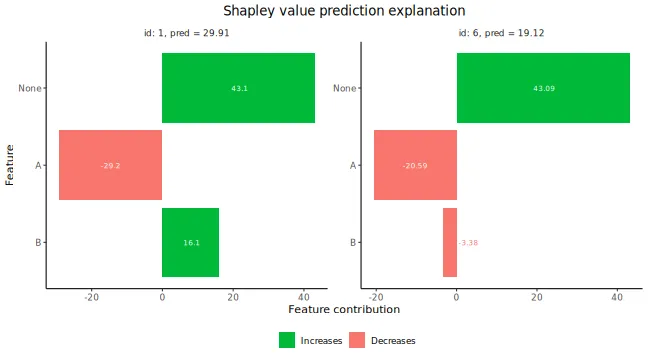
Explain custom models
shapr currently natively supports explanation of
predictions from models fitted with the following functions:
stats::lmstats::glmranger::rangermgcv::gam-
xgboost::xgboost/xgboost::xgb.train workflows::workflow
Any continuous response regression model or binary classification
model of these model classes, can be explained with the package directly
as exemplified above, while we give an example for the
workflows::workflow in the tidymodels/workflows
section. Moreover, essentially any feature dependent prediction model
can be explained by the package by specifying two (or one) simple
additional functions for your model.
The first function is predict_model, taking the model
and data (as a matrix or
data.frame/data.table) as input and outputting the
corresponding prediction as a numeric vector. The second (optional, but
highly recommended) function is get_model_specs, taking the
model as input and outputting a list with the following elements:
labels (vector with the feature names to compute Shapley values
for), classes (a named vector with the labels as names and the
class type as elements), factor_levels (a named list with the
labels as names and vectors with the factor levels as elements (NULL if
the feature is not a factor)). The get_model_specs function
is used to check that the data passed to explain have the
correct format in terms of the necessary feature columns being available
and having the correct class/attributes. It is highly recommended to do
such checks in order to ensure correct usage of explain.
If, for some reason, such checking is not desirable, one does not have
to provide the get_model_specs function. This will,
however, throw a warning that all feature consistency checking against
the model is disabled.
Once the above functions are created, you can explain predictions
from this model as before by passing the functions through the input
arguments predict_model and get_model_specs of
explain().
These functions can be made general enough to handle
all supported model types of that class, or they can be made minimal,
possibly only allowing explanation of the specific version of the model
class at hand. Below we give examples of both full support versions of
these functions and a minimal version which skips the
get_model_specs function. We do this for the
gbm model class from the gbm package, fitted
to the same airquality data set as used above.
library(gbm)
#> Loaded gbm 2.2.2
#> This version of gbm is no longer under development. Consider transitioning to gbm3, https://github.com/gbm-developers/gbm3
formula_gbm <- as.formula(paste0(y_var, "~", paste0(x_var, collapse = "+")))
# Fitting a gbm model
set.seed(825)
model_gbm <- gbm::gbm(
formula_gbm,
data = cbind(x_train, Ozone = y_train),
distribution = "gaussian"
)
#### Full feature versions of the three required model functions ####
MY_predict_model <- function(x, newdata) {
if (!requireNamespace("gbm", quietly = TRUE)) {
stop("The gbm package is required for predicting train models")
}
model_type <- ifelse(
x$distribution$name %in% c("bernoulli", "adaboost"),
"classification",
"regression"
)
if (model_type == "classification") {
predict(x, as.data.frame(newdata), type = "response", n.trees = x$n.trees)
} else {
predict(x, as.data.frame(newdata), n.trees = x$n.trees)
}
}
MY_get_model_specs <- function(x) {
feature_specs <- list()
feature_specs$labels <- labels(x$Terms)
m <- length(feature_specs$labels)
feature_specs$classes <- attr(x$Terms, "dataClasses")[-1]
feature_specs$factor_levels <- setNames(vector("list", m), feature_specs$labels)
feature_specs$factor_levels[feature_specs$classes == "factor"] <- NA # model object doesn't contain factor levels info
return(feature_specs)
}
# Compute the Shapley values
set.seed(123)
p0 <- mean(y_train)
explanation_custom <- explain(
model = model_gbm,
x_explain = x_explain,
x_train = x_train,
approach = "empirical",
phi0 = p0,
seed = 1,
predict_model = MY_predict_model,
get_model_specs = MY_get_model_specs
)
#>
#> ── Starting `shapr::explain()` at 2025-12-20 11:32:29 ──────────────
#> ℹ `max_n_coalitions` is `NULL` or larger than `2^n_features = 16`,
#> and is therefore set to `2^n_features = 16`.
#>
#>
#> ── Explanation overview ──
#>
#>
#>
#> • Model class: <gbm>
#>
#> • v(S) estimation class: Monte Carlo integration
#>
#> • Approach: empirical
#>
#> • Procedure: Non-iterative
#>
#> • Number of Monte Carlo integration samples: 1000
#>
#> • Number of feature-wise Shapley values: 4
#>
#> • Number of observations to explain: 6
#>
#> • Computations (temporary) saved at:
#> '/tmp/RtmpP6cesG/shapr_obj_781db7891af93.rds'
#>
#>
#>
#> ── Main computation started ──
#>
#>
#>
#> ℹ Using 16 of 16 coalitions.
# Plot results
plot(explanation_custom, index_x_explain = c(1, 6))
#> ℹ Showing 2 of 6 observations.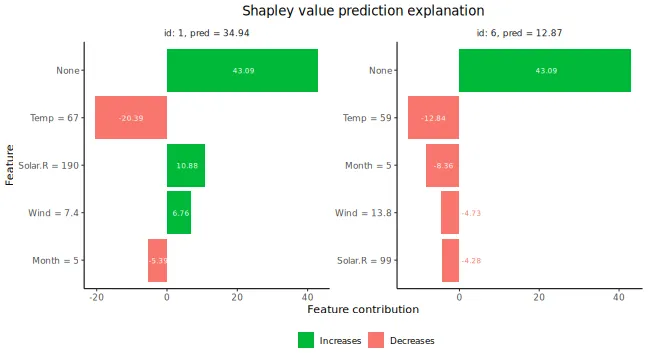
#### Minimal version of the custom model setup ####
# Note: Working only for this exact version of the model class
# Avoiding to define get_model_specs skips all feature
# consistency checking between your data and model
MY_MINIMAL_predict_model <- function(x, newdata) {
predict(x, as.data.frame(newdata), n.trees = x$n.trees)
}
# Compute the Shapley values
set.seed(123)
explanation_custom_minimal <- explain(
model = model_gbm,
x_explain = x_explain,
x_train = x_train,
approach = "empirical",
phi0 = p0,
seed = 1,
predict_model = MY_MINIMAL_predict_model
)
#>
#> ── Starting `shapr::explain()` at 2025-12-20 11:32:32 ──────────────
#> ℹ You passed a model to `shapr::explain()` which is not natively
#> supported, and did not supply a `get_model_specs` function to
#> `shapr::explain()`.
#> Consistency checks between model and data are therefore disabled.ℹ `max_n_coalitions` is `NULL` or larger than `2^n_features = 16`,
#> and is therefore set to `2^n_features = 16`.
#> ── Explanation overview ──
#>
#> • Model class: <gbm>
#> • v(S) estimation class: Monte Carlo integration
#> • Approach: empirical
#> • Procedure: Non-iterative
#> • Number of Monte Carlo integration samples: 1000
#> • Number of feature-wise Shapley values: 4
#> • Number of observations to explain: 6
#> • Computations (temporary) saved at:
#> '/tmp/RtmpP6cesG/shapr_obj_781db396a5440.rds'
#>
#> ── Main computation started ──
#>
#> ℹ Using 16 of 16 coalitions.
# Plot results
plot(explanation_custom_minimal, index_x_explain = c(1, 6))
#> ℹ Showing 2 of 6 observations.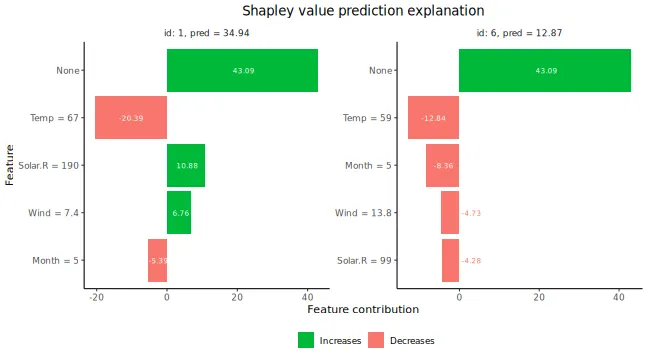
Tidymodels and workflows
In this section, we demonstrate how to use shapr to
explain tidymodels models fitted using
workflows. In the example above, we
directly used the xgboost package to fit the
xgboost model. However, we can also fit the
xgboost model using the tidymodels package.
These fits will be identical, as tidymodels calls
xgboost internally, which we demonstrate in the example
below. Note that we can replace xgboost (i.e.,
parsnip::boost_tree) with any other fitted
tidymodels model in the workflows procedure
outlined below.
# Fitting a basic xgboost model to the training data using tidymodels
set.seed(123) # Set the same seed as above
all_var <- c(y_var, x_var)
train <- data[-ind_x_explain, ..all_var]
# Fitting the `tidymodels` model using `workflows`
model_tidymodels <- parsnip::fit(
workflows::add_recipe(
workflows::add_model(
workflows::workflow(),
parsnip::boost_tree(trees = 20, engine = "xgboost", mode = "regression")
),
recipes::recipe(Ozone ~ ., data = train)
),
data = train
)
# # We can also specify the same model using pipes `%>%` by (if pipes are installed/loaded)
# model_tidymodels <-
# workflows::workflow() %>%
# workflows::add_model(parsnip::boost_tree(trees = 20, engine = "xgboost", mode = "regression")) %>%
# workflows::add_recipe(recipes::recipe(Ozone ~ ., data = train)) %>%
# parsnip::fit(data = train)
# See that the output of the two models are identical
all.equal(predict(model_tidymodels, x_train)$.pred, predict(model, as.matrix(x_train)))
#> [1] TRUE
# Create the Shapley values for the tidymodels version
explanation_tidymodels <- explain(
model = model_tidymodels,
x_explain = x_explain,
x_train = x_train,
approach = "empirical",
phi0 = p0,
seed = 1
)
#>
#> ── Starting `shapr::explain()` at 2025-12-20 11:32:36 ──────────────
#> ℹ `max_n_coalitions` is `NULL` or larger than `2^n_features = 16`,
#> and is therefore set to `2^n_features = 16`.
#>
#>
#> ── Explanation overview ──
#>
#>
#>
#> • Model class: <workflow>
#>
#> • v(S) estimation class: Monte Carlo integration
#>
#> • Approach: empirical
#>
#> • Procedure: Non-iterative
#>
#> • Number of Monte Carlo integration samples: 1000
#>
#> • Number of feature-wise Shapley values: 4
#>
#> • Number of observations to explain: 6
#>
#> • Computations (temporary) saved at:
#> '/tmp/RtmpP6cesG/shapr_obj_781db3931caec.rds'
#>
#>
#>
#> ── Main computation started ──
#>
#>
#>
#> ℹ Using 16 of 16 coalitions.
# See that the Shapley value explanations are identical too
all.equal(explanation$shapley_values_est, explanation_tidymodels$shapley_values_est)
#> [1] TRUEThe parameters of the vaeac approach
The vaeac approach is a very flexible method that
supports mixed data. The main parameters are the number of layers in the
networks (vaeac.depth), the width of the layers
(vaeac.width), the number of dimensions in the latent space
(vaeac.latent_dim), the activation function between the
layers in the networks (vaeac.activation_function), the
learning rate in the ADAM optimizer (vaeac.lr), the number
of vaeac models to initiate to remedy poorly initiated
model parameter values (vaeac.n_vaeacs_initialize), and the
number of learning epochs (vaeac.epochs). Call
?shapr::setup_approach.vaeac for a more detailed
description of the parameters.
There are additional extra parameters which can be set by including a
named list in the call to the explain() function. For
example, we can change the batch size to 32 by including
vaeac.extra_parameters = list(vaeac.batch_size = 32) as a
parameter in the call to the explain() function. See
?shapr::vaeac_get_extra_para_default for a description of
the possible extra parameters to the vaeac approach. The
main parameters are directly entered to the explain()
function, while the extra parameters are included in a named list called
vaeac.extra_parameters.
explanation_vaeac <- explain(
model = model,
x_explain = x_explain,
x_train = x_train,
approach = "vaeac",
phi0 = p0,
seed = 1,
n_MC_samples = 100,
vaeac.width = 16,
vaeac.depth = 2,
vaeac.epochs = 3,
vaeac.n_vaeacs_initialize = 2
)
#>
#> ── Starting `shapr::explain()` at 2025-12-20 11:32:40 ──────────────
#> ℹ `max_n_coalitions` is `NULL` or larger than `2^n_features = 16`,
#> and is therefore set to `2^n_features = 16`.
#>
#>
#> ── Explanation overview ──
#>
#>
#>
#> • Model class: <xgboost>
#>
#> • v(S) estimation class: Monte Carlo integration
#>
#> • Approach: vaeac
#>
#> • Procedure: Non-iterative
#>
#> • Number of Monte Carlo integration samples: 100
#>
#> • Number of feature-wise Shapley values: 4
#>
#> • Number of observations to explain: 6
#>
#> • Computations (temporary) saved at:
#> '/tmp/RtmpP6cesG/shapr_obj_781db70f70cf9.rds'
#>
#>
#>
#> ── Main computation started ──
#>
#>
#>
#> ℹ Using 16 of 16 coalitions.We can look at the training and validation errors for the trained
vaeac model and see that vaeac.epochs = 3 is
likely too few epochs, as it still seems like the vaeac
model is learning.
# Look at the training and validation errors.
plot_vaeac_eval_crit(list("Vaeac 3 epochs" = explanation_vaeac), plot_type = "method")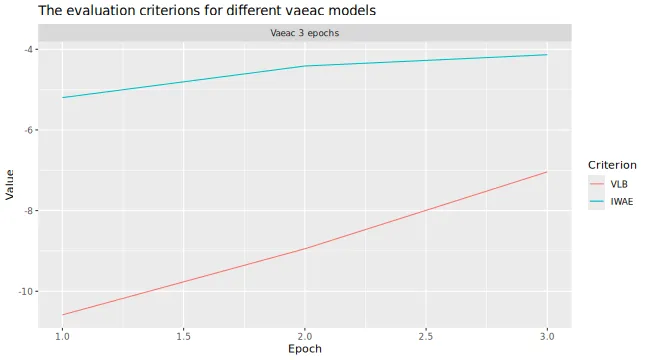
Early stopping
If we are uncertain about the choice of vaeac.epochs, we
can rather use vaeac with early stopping. We will then set
vaeac.epochs to a large number, which will act as a maximum
number of allowed epochs, and in the vaeac.extra_parameters
list we set vaeac.epochs_early_stopping to the number of
epochs we allow the vaeac model to not improve its
validation score. That is, if
vaeac.epochs_early_stopping = 2, then vaeac
will stop the training procedure if there has been no improvement in the
validation score for 2 consecutive epochs, or if
vaeac.epochs is reached. Note that if using early stopping
and progress updates simultaneously, then the estimated timer remaining
will obviously be incorrect if early stopping is applied. Furthermore, a
value of 2 is too low for real world applications, but we
set it so low here to make the vignette faster to build.
explanation_vaeac_early_stop <- explain(
model = model,
x_explain = x_explain,
x_train = x_train,
approach = "vaeac",
phi0 = p0,
seed = 1,
n_MC_samples = 100,
vaeac.width = 16,
vaeac.depth = 2,
vaeac.epochs = 1000, # Set it to a large number
vaeac.n_vaeacs_initialize = 2,
vaeac.extra_parameters = list(vaeac.epochs_early_stopping = 2)
)
#>
#> ── Starting `shapr::explain()` at 2025-12-20 11:32:56 ──────────────
#> ℹ `max_n_coalitions` is `NULL` or larger than `2^n_features = 16`,
#> and is therefore set to `2^n_features = 16`.
#>
#>
#> ── Explanation overview ──
#>
#>
#>
#> • Model class: <xgboost>
#>
#> • v(S) estimation class: Monte Carlo integration
#>
#> • Approach: vaeac
#>
#> • Procedure: Non-iterative
#>
#> • Number of Monte Carlo integration samples: 100
#>
#> • Number of feature-wise Shapley values: 4
#>
#> • Number of observations to explain: 6
#>
#> • Computations (temporary) saved at:
#> '/tmp/RtmpP6cesG/shapr_obj_781db67aad741.rds'
#>
#>
#>
#> ── Main computation started ──
#>
#>
#>
#> ℹ Using 16 of 16 coalitions.Can compare with the previous version and see that the results are more stable now.
# Look at the training and validation errors.
plot_vaeac_eval_crit(
list("Vaeac 3 epochs" = explanation_vaeac, "Vaeac early stopping" = explanation_vaeac_early_stop),
plot_type = "method"
)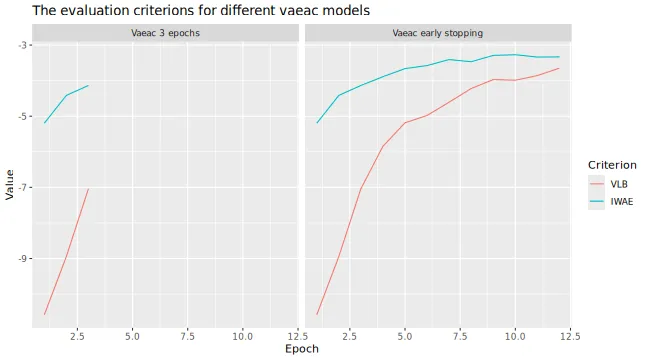
Can also compare the evaluation scores.
plot_MSEv_eval_crit(list("Vaeac 3 epochs" = explanation_vaeac, "Vaeac early stopping" = explanation_vaeac_early_stop))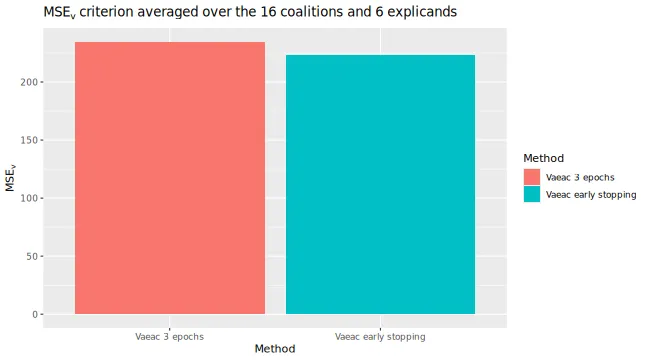
Continued computation
In this section, we demonstrate how to continue to improve estimation
accuracy with additional coalition samples, from a previous Shapley
value computation based on shapr::explain() with the
iterative estimation procedure. This can be done either by passing an
existing object of class shapr, or by passing a string with
the path to the intermediately saved results. The latter is found at
SHAPR_OBJ$saving_path, defaults to a temporary folder, and
is updated after each iteration. This can be particularly handy for
long-running computations.
# First we run the computation with the iterative estimation procedure for a limited number of coalition samples
library(xgboost)
library(data.table)
data("airquality")
data <- data.table::as.data.table(airquality)
data <- data[complete.cases(data), ]
x_var <- c("Solar.R", "Wind", "Temp", "Month", "Day")
y_var <- "Ozone"
ind_x_explain <- 1:6
x_train <- data[-ind_x_explain, ..x_var]
y_train <- data[-ind_x_explain, get(y_var)]
x_explain <- data[ind_x_explain, ..x_var]
# Set seed for reproducibility
set.seed(123)
# Fitting a basic xgboost model to the training data
model <- xgboost::xgboost(
x = x_train,
y = y_train,
nround = 20,
verbosity = 0
)
# Specifying the phi_0, i.e. the expected prediction without any features
p0 <- mean(y_train)
# Initial explanation computation
ex_init <- explain(
model = model,
x_explain = x_explain,
x_train = x_train,
approach = "gaussian",
phi0 = p0,
seed = 1,
max_n_coalitions = 20,
iterative = TRUE
)
#>
#> ── Starting `shapr::explain()` at 2025-12-20 11:33:19 ──────────────
#>
#> ── Explanation overview ──
#>
#> • Model class: <xgboost>
#> • v(S) estimation class: Monte Carlo integration
#> • Approach: gaussian
#> • Procedure: Iterative
#> • Number of Monte Carlo integration samples: 1000
#> • Number of feature-wise Shapley values: 5
#> • Number of observations to explain: 6
#> • Computations (temporary) saved at:
#> '/tmp/RtmpP6cesG/shapr_obj_781db5e05cd09.rds'
#>
#> ── Iterative computation started ──
#>
#> ── Iteration 1 ─────────────────────────────────────────────────────
#> ℹ Using 6 of 32 coalitions, 6 new.
#>
#> ── Iteration 2 ─────────────────────────────────────────────────────
#> ℹ Using 8 of 32 coalitions, 2 new.
#>
#> ── Iteration 3 ─────────────────────────────────────────────────────
#> ℹ Using 12 of 32 coalitions, 4 new.
#>
#> ── Iteration 4 ─────────────────────────────────────────────────────
#> ℹ Using 18 of 32 coalitions, 6 new.
#>
#> ── Iteration 5 ─────────────────────────────────────────────────────
#> ℹ Using 20 of 32 coalitions, 2 new.
# Using the ex_init object to continue the computation with 4 more coalition samples
ex_further <- explain(
model = model,
x_explain = x_explain,
x_train = x_train,
approach = "gaussian",
phi0 = p0,
seed = 1,
max_n_coalitions = 24,
iterative_args = list(convergence_tol = 0.005), # Decrease the convergence threshold
prev_shapr_object = ex_init
)
#>
#> ── Starting `shapr::explain()` at 2025-12-20 11:33:25 ──────────────
#>
#> ── Explanation overview ──
#>
#> • Model class: <xgboost>
#> • v(S) estimation class: Monte Carlo integration
#> • Approach: gaussian
#> • Procedure: Non-iterative
#> • Number of Monte Carlo integration samples: 1000
#> • Number of feature-wise Shapley values: 5
#> • Number of observations to explain: 6
#> • Computations (temporary) saved at:
#> '/tmp/RtmpP6cesG/shapr_obj_781db394d5535.rds'
#>
#> ── Main computation started ──
#>
#> ℹ Using 24 of 32 coalitions.
ex_further_path <- get_results(ex_further, what = "saving_path") # Gets path to the saved intermediate estimation object
# Using the ex_init object to continue the computation for the remaining coalition samples
# but this time using the path to the saved intermediate estimation object
ex_even_further <- explain(
model = model,
x_explain = x_explain,
x_train = x_train,
approach = "gaussian",
phi0 = p0,
seed = 1,
max_n_coalitions = NULL,
prev_shapr_object = ex_further_path
)
#>
#> ── Starting `shapr::explain()` at 2025-12-20 11:33:26 ──────────────
#> ℹ `max_n_coalitions` is `NULL` or larger than `2^n_features = 32`,
#> and is therefore set to `2^n_features = 32`.
#>
#>
#> ── Explanation overview ──
#>
#>
#>
#> • Model class: <xgboost>
#>
#> • v(S) estimation class: Monte Carlo integration
#>
#> • Approach: gaussian
#>
#> • Procedure: Non-iterative
#>
#> • Number of Monte Carlo integration samples: 1000
#>
#> • Number of feature-wise Shapley values: 5
#>
#> • Number of observations to explain: 6
#>
#> • Computations (temporary) saved at:
#> '/tmp/RtmpP6cesG/shapr_obj_781db6d588640.rds'
#>
#>
#>
#> ── Main computation started ──
#>
#>
#>
#> ℹ Using 26 of 32 coalitions.Explaining a forecasting model using
explain_forecast
shapr provides a specific function,
explain_forecast, to explain forecasts from time series
models, at one or more steps into the future. The main difference
compared to explain is that the data is supplied as (set
of) time series, in addition to index arguments (train_idx
and explain_idx) specifying which time points that
represents the train and explain parts of the data. See
?explain_forecast for more information.
To demonstrate how to use the function, 500 observations are
generated which follow an AR(1) structure, i.e.
.
To this data an arima model of order (2, 0, 0) is fitted, and we
therefore would like to explain the forecasts in terms of the two
previous lags of the time series. This is is specified through the
argument explain_y_lags = 2. Note that some models may also
put restrictions on the amount of data required to make a forecast. The
AR(2) model we used there, for instance, requires two previous time
point to make a forecast.
In the example, two separate forecasts, each three steps ahead, are
explained. To set the starting points of the two forecasts,
explain_idx is set to 499:500. This means that
one forecast of
and another of
,
will be explained. In other words, explain_idx tells
shapr at which points in time data was available up until,
when making the forecast to explain.
In the same way, train_idx denotes the points in time
used to estimate the conditional expectations used to explain the
different forecasts. Note that since we want to explain the forecasts in
terms of the two previous lags (explain_y_lags = 2), the
smallest value of train_idx must also be 2, because at time
there was only a single observation available.
Since the data is stationary, the mean of the data is used as value
of phi0
(i.e. ).
This can however be chosen differently depending on the data and
application.
For a multivariate model such as a VAR (Vector AutoRegressive model),
it may be more interesting to explain the impact of each variable,
rather than each lag of each variable. This can be done by setting
group_lags = TRUE.
# Simulate time series data with AR(1)-structure.
set.seed(1)
data_ts <- data.frame(Y = arima.sim(list(order = c(1, 0, 0), ar = .5), n = 500))
data_ts <- data.table::as.data.table(data_ts)
# Fit an ARIMA(2, 0, 0) model.
arima_model <- arima(data_ts, order = c(2, 0, 0))
# Set prediction zero as the mean of the data for each forecast point.
p0_ar <- rep(mean(data_ts$Y), 3)
# Explain forecasts from points t = 499 and t = 500.
explain_idx <- 499:500
explanation_forecast <- explain_forecast(
model = arima_model,
y = data_ts,
train_idx = 2:498,
explain_idx = 499:500,
explain_y_lags = 2,
horizon = 3,
approach = "empirical",
phi0 = p0_ar,
group_lags = FALSE
)
#>
#> ── Starting `shapr::explain_forecast()` at 2025-12-20 11:33:27 ─────
#> ℹ Feature names extracted from the model contain `NA`.
#> Consistency checks between model and data are therefore disabled.
#> ℹ `max_n_coalitions` is `NULL` or larger than `2^n_features = 4`,
#> and is therefore set to `2^n_features = 4`.
#> Registered S3 method overwritten by 'quantmod':
#> method from
#> as.zoo.data.frame zoo
#>
#>
#>
#> ── Explanation overview ──
#>
#>
#>
#> • Model class: <Arima>
#>
#> • v(S) estimation class: Monte Carlo integration
#>
#> • Approach: empirical
#>
#> • Procedure: Non-iterative
#>
#> • Number of Monte Carlo integration samples: 1000
#>
#> • Number of feature-wise Shapley values: 2
#>
#> • Number of observations to explain: 2
#>
#> • Computations (temporary) saved at:
#> '/tmp/RtmpP6cesG/shapr_obj_781dbe8acdf4.rds'
#>
#>
#>
#> ── Main computation started ──
#>
#>
#>
#> ℹ Using 4 of 4 coalitions.
explanation_forecast
#> explain_idx horizon none Y.1 Y.2
#> <int> <int> <num> <num> <num>
#> 1: 499 1 0.0402 0.505 -0.0766
#> 2: 500 1 0.0402 -0.362 0.0250
#> 3: 499 2 0.0402 0.505 -0.0766
#> 4: 500 2 0.0402 -0.362 0.0250
#> 5: 499 3 0.0402 0.505 -0.0766
#> 6: 500 3 0.0402 -0.362 0.0250Note that for a multivariate model such as a VAR (Vector
AutoRegressive model), or for models also including several exogenous
variables, it may be more informative to explain the impact of each
variable, rather than each lag of each variable. This can be done by
setting group_lags = TRUE. This does not make sense for
this model, however, as that would result in decomposing the forecast
into a single group.
We now give a more hands-on example of how to use the
explain_forecast function. Say that we have an AR(2) model
which describes the change over time of the variable Temp
in the dataset airquality. It seems reasonable to assume
that the temperature today should affect the temperature tomorrow. To a
lesser extent, we may also suggest that the temperature today should
also have an impact on that of the day after tomorrow.
We start by building our AR(2) model, naming it
model_ar_temp. This model is then used to make a forecast
of the temperature of the day that comes after the last day in the data,
this forecast starts from index 153.
data_ts2 <- data.table::as.data.table(airquality)
model_ar_temp <- ar(data_ts2$Temp, order = 2)
predict(model_ar_temp, n.ahead = 2)$pred
#> Time Series:
#> Start = 154
#> End = 155
#> Frequency = 1
#> [1] 71.081 71.524First, we pass the model and the data as model and
y. Since we have an AR(2) model, we want to explain the
forecasts in terms of the two previous lags, which we specify with
explain_y_lags = 2. Then, we let shapr know
which time indices to use as training data through the argument
train_idx. We use 2:152, meaning that we skip
the first index, as we want to explain the two previous lags. Letting
the training indices go up until 152 means that every point in time
except the first and last will be used as training data.
The last index, 153 is passed as the argument
explain_idx, which means that we want to explain a forecast
made from time point 153 in the data. The argument horizon
is set to 2 in order to explain a forecast of length 2.
The argument phi0 is set to the mean of the time series,
and is repeated two times. Each value of phi0 is the
baseline for each forecast horizon. In our example, we assume that given
no effect from the two lags, the temperature would just be the average
during the observed period. Finally, we opt to not group the lags by
setting group_lags to FALSE. This means that
lag 1 and 2 will be explained separately. Grouping lags may be more
interesting to do in a model with multiple variables, as it is then
possible to explain each variable separately.
explanation_forecast <- explain_forecast(
model = model_ar_temp,
y = data_ts2[, "Temp"],
train_idx = 2:152,
explain_idx = 153,
explain_y_lags = 2,
horizon = 2,
approach = "empirical",
phi0 = rep(mean(data$Temp), 2),
group_lags = FALSE
)
#>
#> ── Starting `shapr::explain_forecast()` at 2025-12-20 11:33:30 ─────
#> ℹ Feature names extracted from the model contain `NA`.
#> Consistency checks between model and data are therefore disabled.
#> ℹ `max_n_coalitions` is `NULL` or larger than `2^n_features = 4`,
#> and is therefore set to `2^n_features = 4`.
#>
#>
#> ── Explanation overview ──
#>
#>
#>
#> • Model class: <ar>
#>
#> • v(S) estimation class: Monte Carlo integration
#>
#> • Approach: empirical
#>
#> • Procedure: Non-iterative
#>
#> • Number of Monte Carlo integration samples: 1000
#>
#> • Number of feature-wise Shapley values: 2
#>
#> • Number of observations to explain: 1
#>
#> • Computations (temporary) saved at:
#> '/tmp/RtmpP6cesG/shapr_obj_781db4821097f.rds'
#>
#>
#>
#> ── Main computation started ──
#>
#>
#>
#> ℹ Using 4 of 4 coalitions.
print(explanation_forecast)
#> explain_idx horizon none Temp.1 Temp.2
#> <int> <int> <num> <num> <num>
#> 1: 153 1 77.8 -6.58 -0.134
#> 2: 153 2 77.8 -5.98 -0.288The results are presented per value of explain_idx and
forecast horizon. We can see that the mean temperature was around 77.9
degrees. At horizon 1, the first lag in the model caused it to be 6.6
degrees lower, and the second lag had just a minor effect. At horizon 2,
the first lag has a slightly smaller negative impact, and the second lag
has a slightly larger impact.
It is also possible to explain a forecasting model which uses
exogenous regressors. The previous example is expanded to use an
ARIMA(2,0,0) model with Wind as an exogenous regressor.
Since the exogenous regressor must be available for the predicted time
points, the model is just fit on the 151 first observations, leaving two
observations of Wind to be used as exogenous values during
the prediction phase.
data_ts3 <- data.table::as.data.table(airquality)
data_fit <- data_ts3[seq_len(151), ]
model_arimax_temp <- arima(data_fit$Temp, order = c(2, 0, 0), xreg = data_fit$Wind)
newxreg <- data_ts3[-seq_len(151), "Wind", drop = FALSE]
predict(model_arimax_temp, n.ahead = 2, newxreg = newxreg)$pred
#> Time Series:
#> Start = 152
#> End = 153
#> Frequency = 1
#> [1] 77.500 76.381The shapr package can then explain not only the two
autoregressive lags, but also the single lag of the exogenous regressor.
In order to do so, the Wind variable is passed as the
argument xreg, and explain_xreg_lags is set to
1. Notice how only the first 151 observations are used for
y and all 153 are used for xreg. This makes it
possible for shapr to not only explain the effect of the
first lag of the exogenous variable, but also the contemporary effect
during the forecasting period.
explanation_forecast <- explain_forecast(
model = model_ar_temp,
y = data_fit[, "Temp"],
xreg = data_ts3[, "Wind"],
train_idx = 2:150,
explain_idx = 151,
explain_y_lags = 2,
explain_xreg_lags = 1,
horizon = 2,
approach = "empirical",
phi0 = rep(mean(data_fit$Temp), 2),
group_lags = FALSE
)
#>
#> ── Starting `shapr::explain_forecast()` at 2025-12-20 11:33:32 ─────
#> ℹ Feature names extracted from the model contain `NA`.
#> Consistency checks between model and data are therefore disabled.
#> ℹ `max_n_coalitions` is `NULL` or larger than `2^n_features = 32`,
#> and is therefore set to `2^n_features = 32`.
#>
#>
#> ── Explanation overview ──
#>
#>
#>
#> • Model class: <ar>
#>
#> • v(S) estimation class: Monte Carlo integration
#>
#> • Approach: empirical
#>
#> • Procedure: Non-iterative
#>
#> • Number of Monte Carlo integration samples: 1000
#>
#> • Number of feature-wise Shapley values: 5
#>
#> • Number of observations to explain: 1
#>
#> • Computations (temporary) saved at:
#> '/tmp/RtmpP6cesG/shapr_obj_781db511fb05a.rds'
#>
#>
#>
#> ── Main computation started ──
#>
#>
#>
#> ℹ Using 32 of 32 coalitions.
print(explanation_forecast)
#> explain_idx horizon none Temp.1 Temp.2 Wind.1 Wind.F1 Wind.F2
#> <int> <int> <num> <num> <num> <num> <num> <num>
#> 1: 151 1 78 -0.678 -0.673 -1.27 0.4934 NA
#> 2: 151 2 78 0.400 -0.501 -1.47 0.0659 -0.474
summary(explanation_forecast)
#>
#> ── Summary of Shapley value explanation ────────────────────────────
#> • Computed with `shapr::explain_forecast()` in 4.8 seconds, started
#> 2025-12-20 11:33:32
#> • Model class: <ar>
#> • v(S) estimation class: Monte Carlo integration
#> • Approach: empirical
#> • Procedure: Non-iterative
#> • Number of Monte Carlo integration samples: 1000
#> • Number of feature-wise Shapley values: 5
#> • Number of observations to explain: 1
#> • Number of coalitions used: 32 (of total 32)
#> • Computations (temporary) saved at:
#> '/tmp/RtmpP6cesG/shapr_obj_781db511fb05a.rds'
#>
#> ── Estimated Shapley values
#> explain_idx horizon none Temp.1 Temp.2 Wind.1 Wind.F1 Wind.F2
#> <int> <int> <char> <char> <char> <char> <char> <char>
#> 1: 151 1 77.96 -0.68 -0.67 -1.27 0.49 NA
#> 2: 151 2 77.96 0.40 -0.50 -1.47 0.07 -0.47